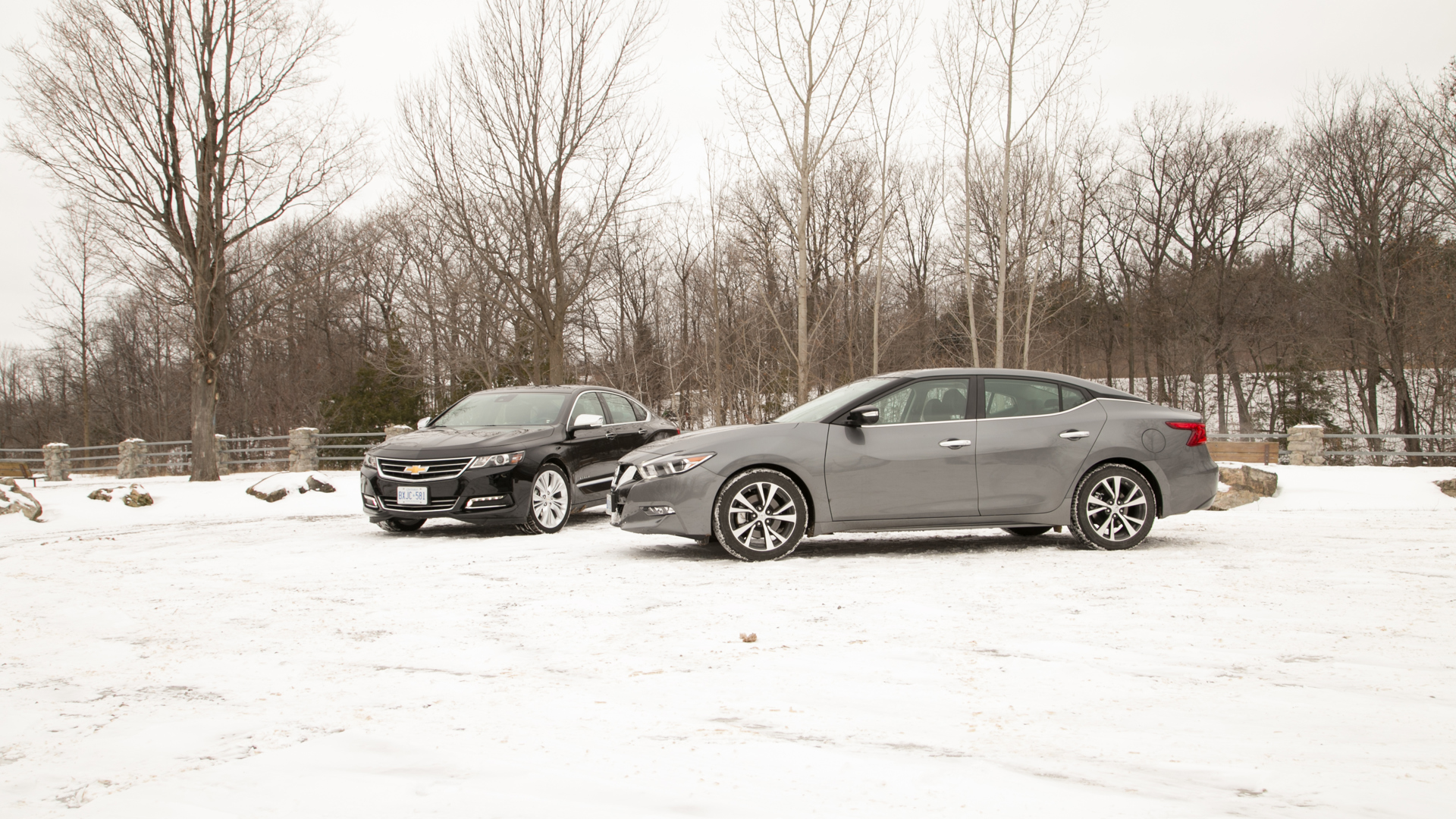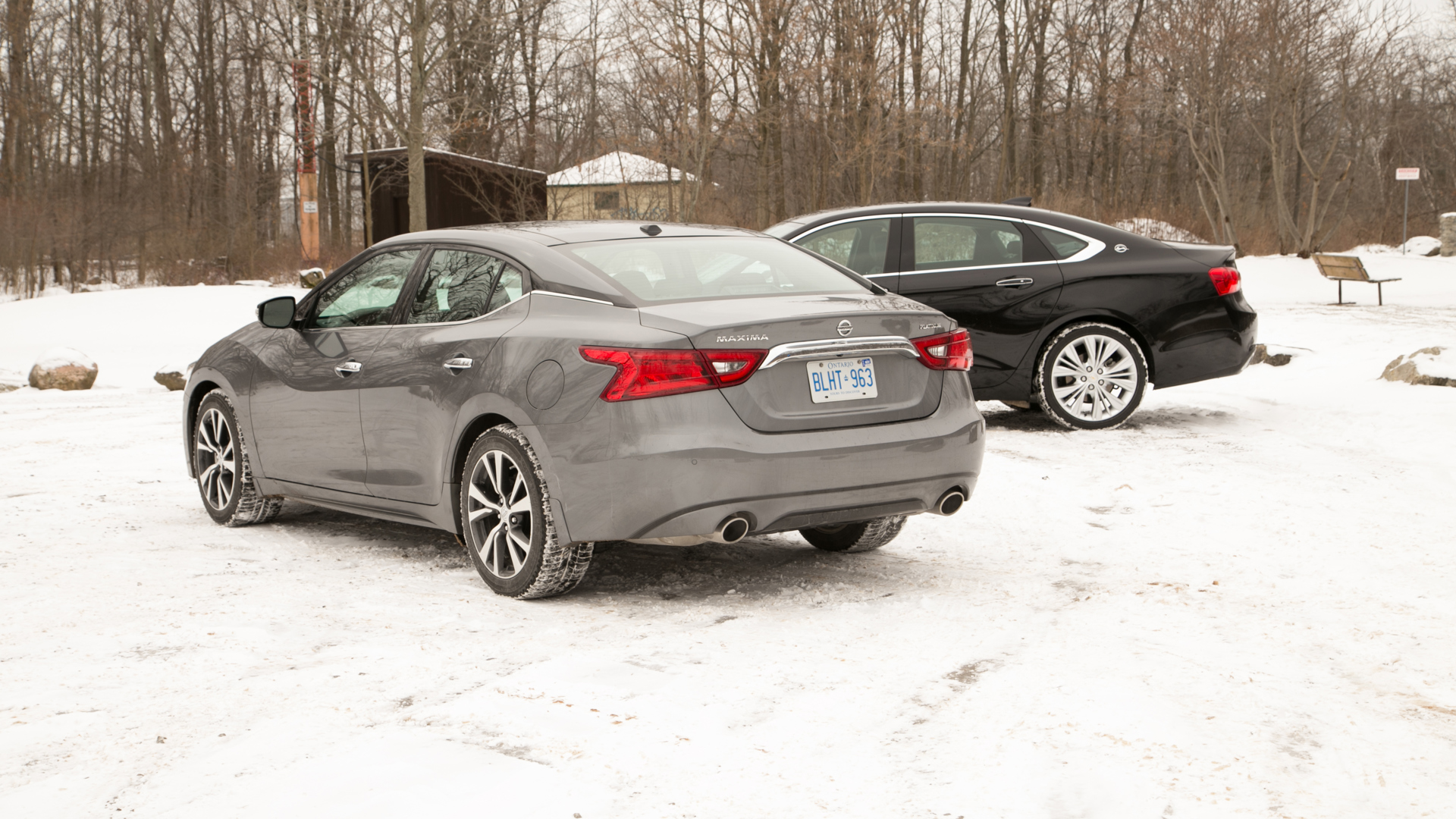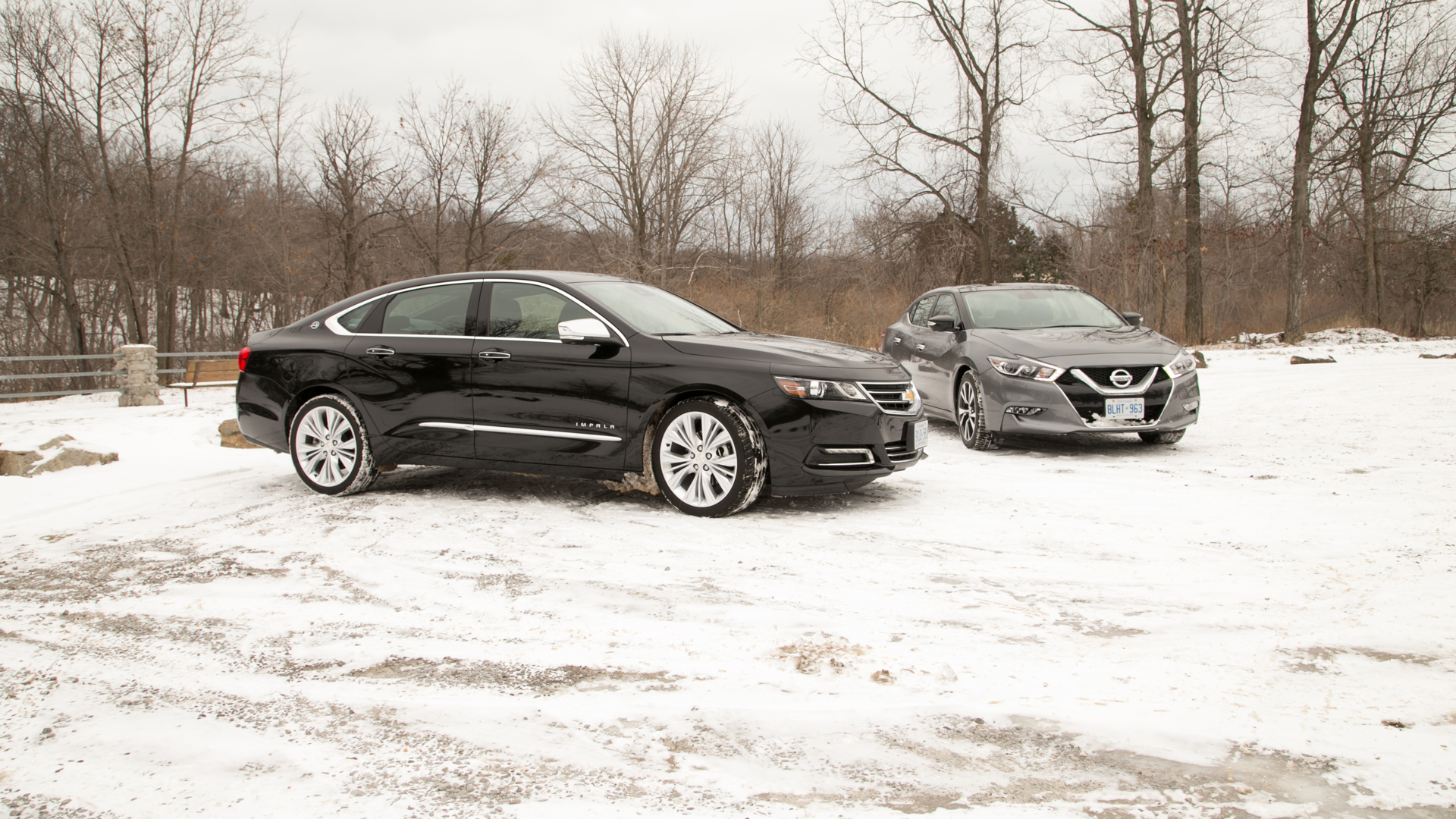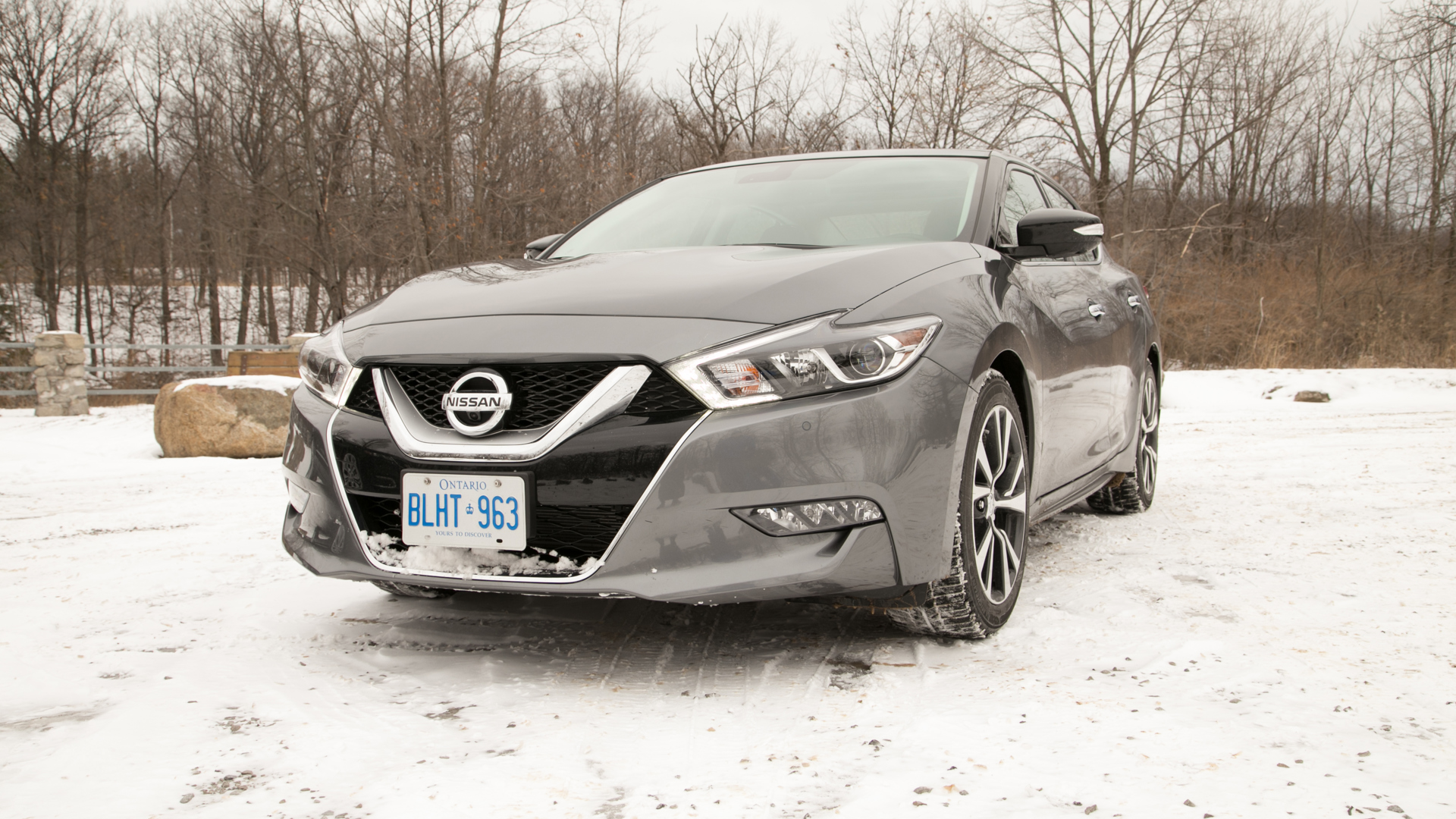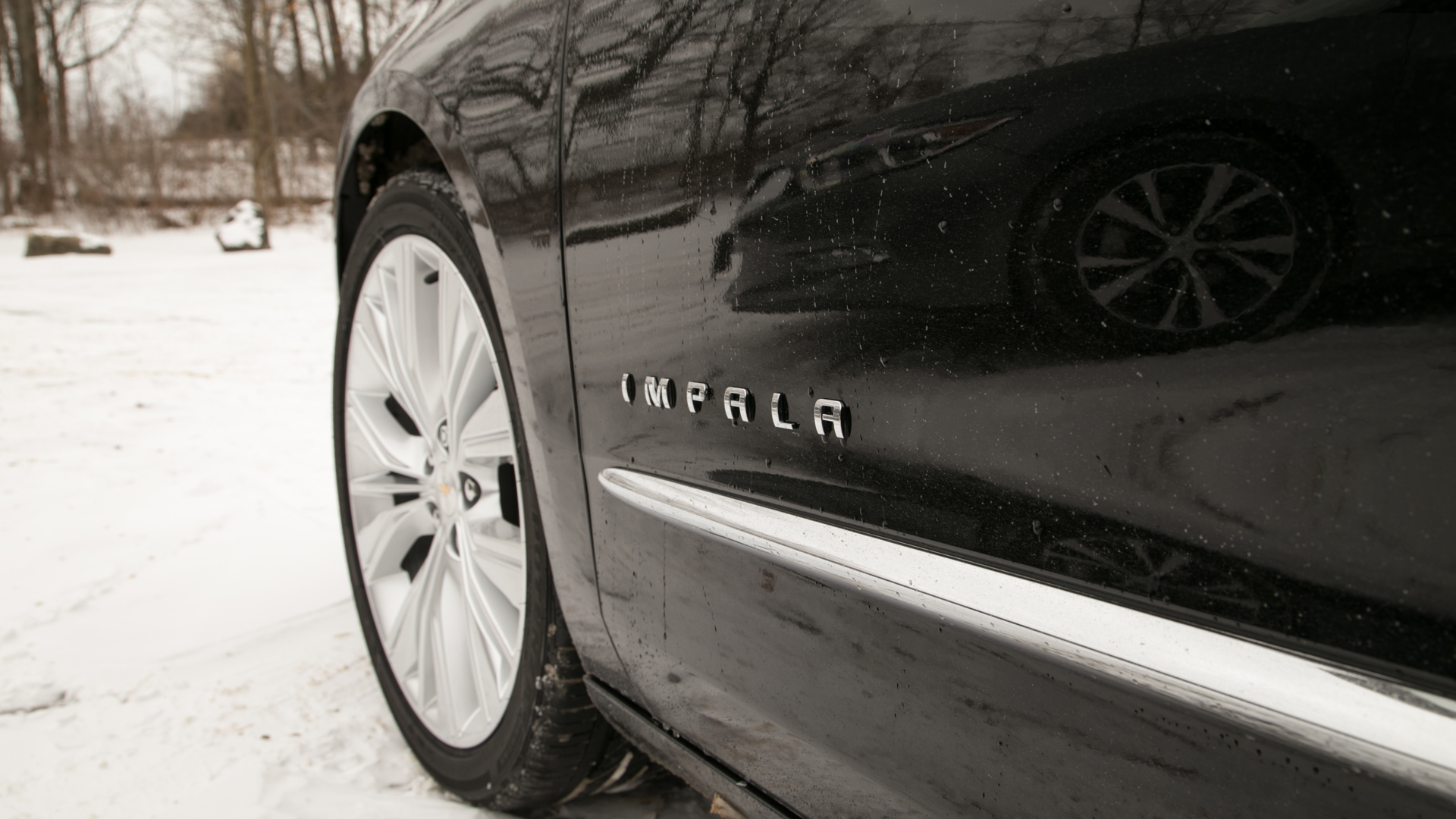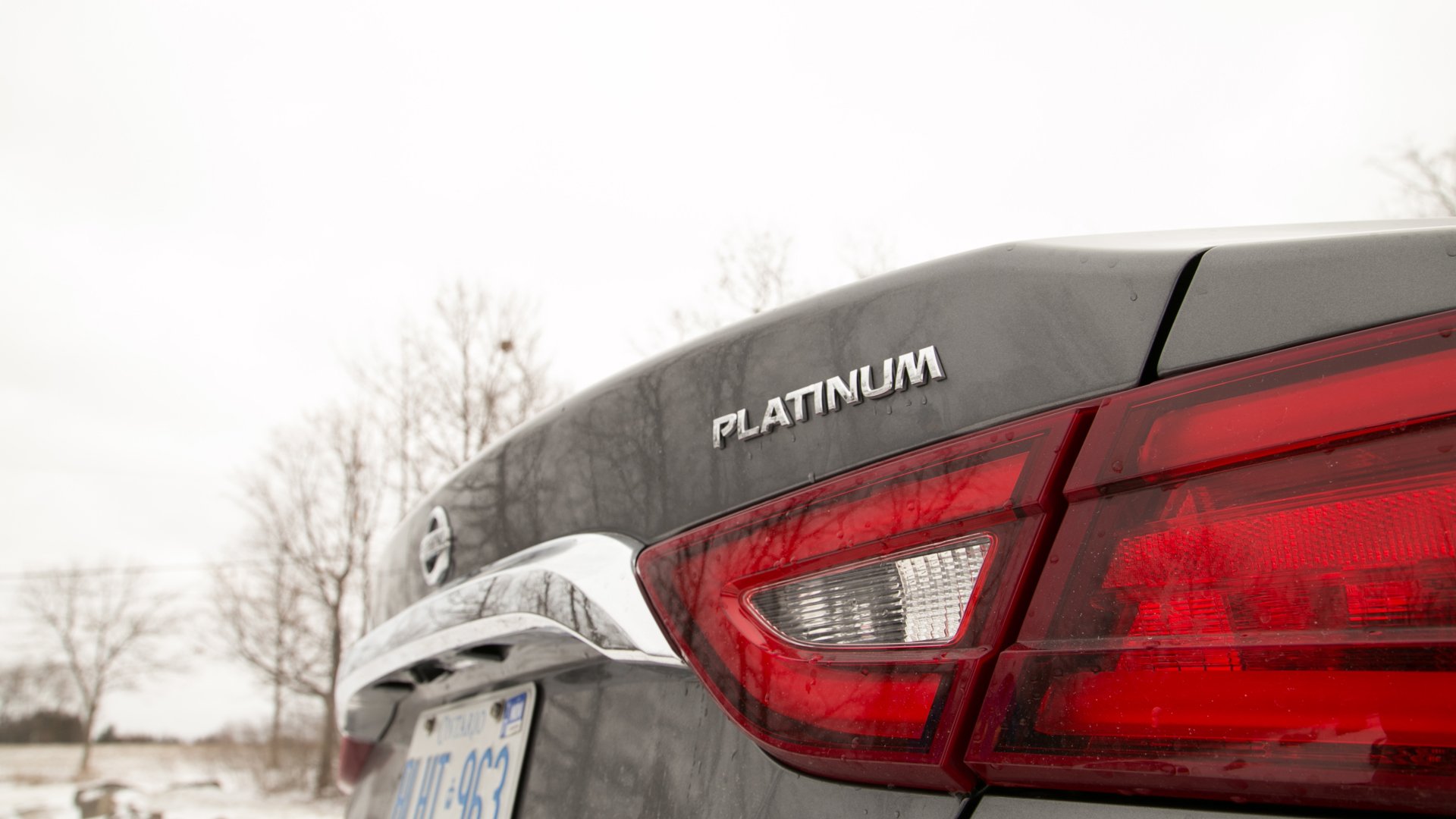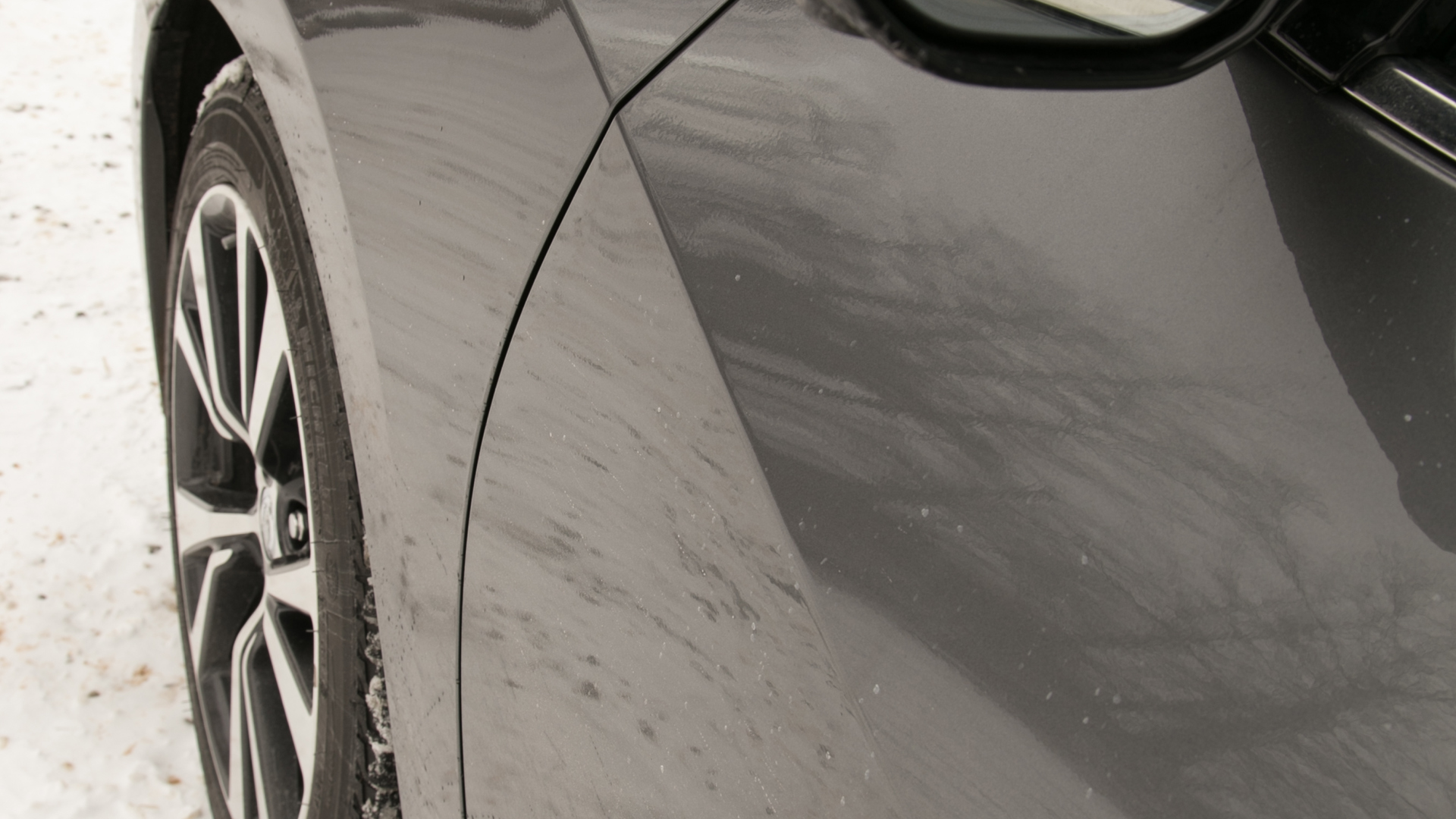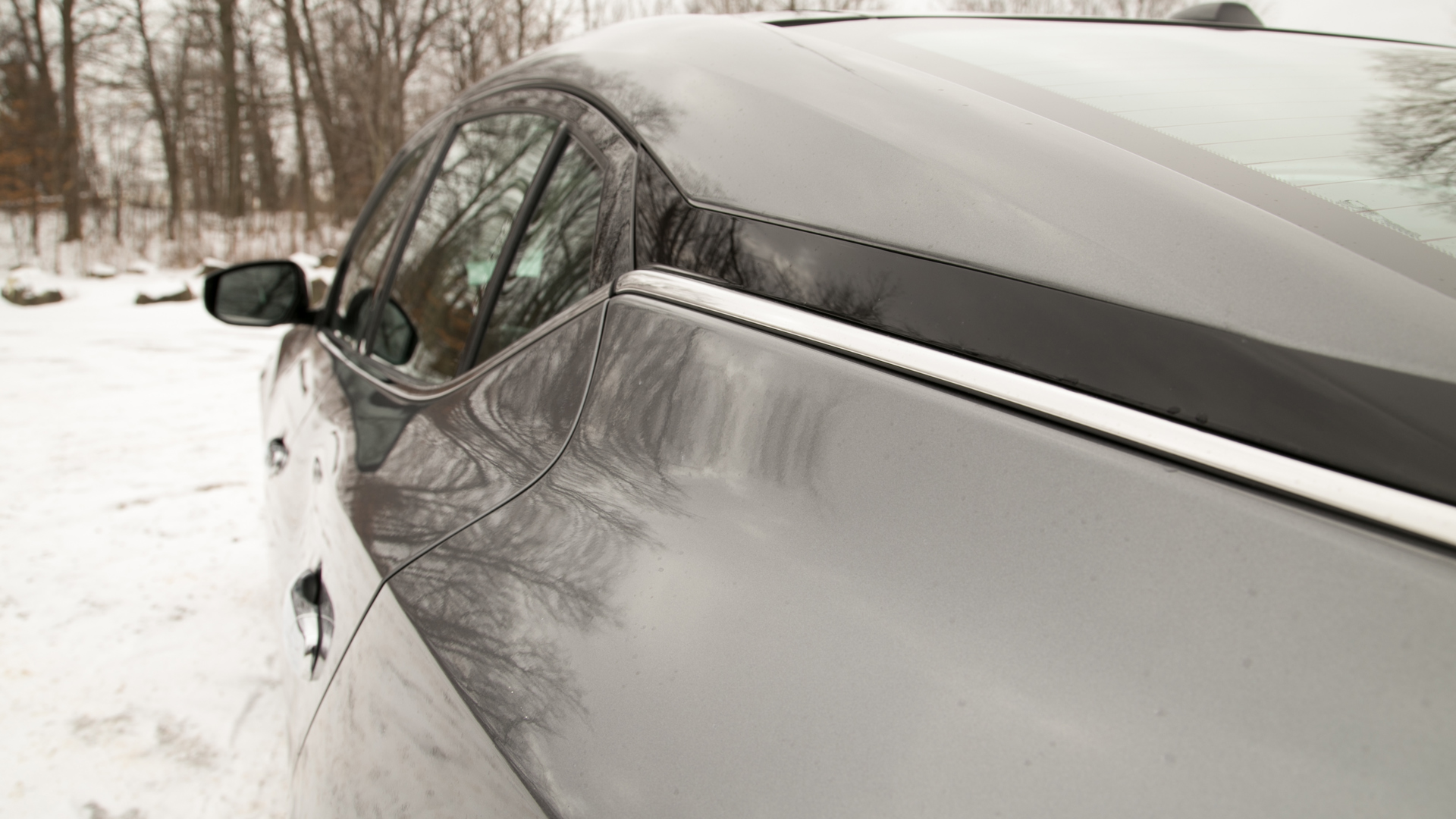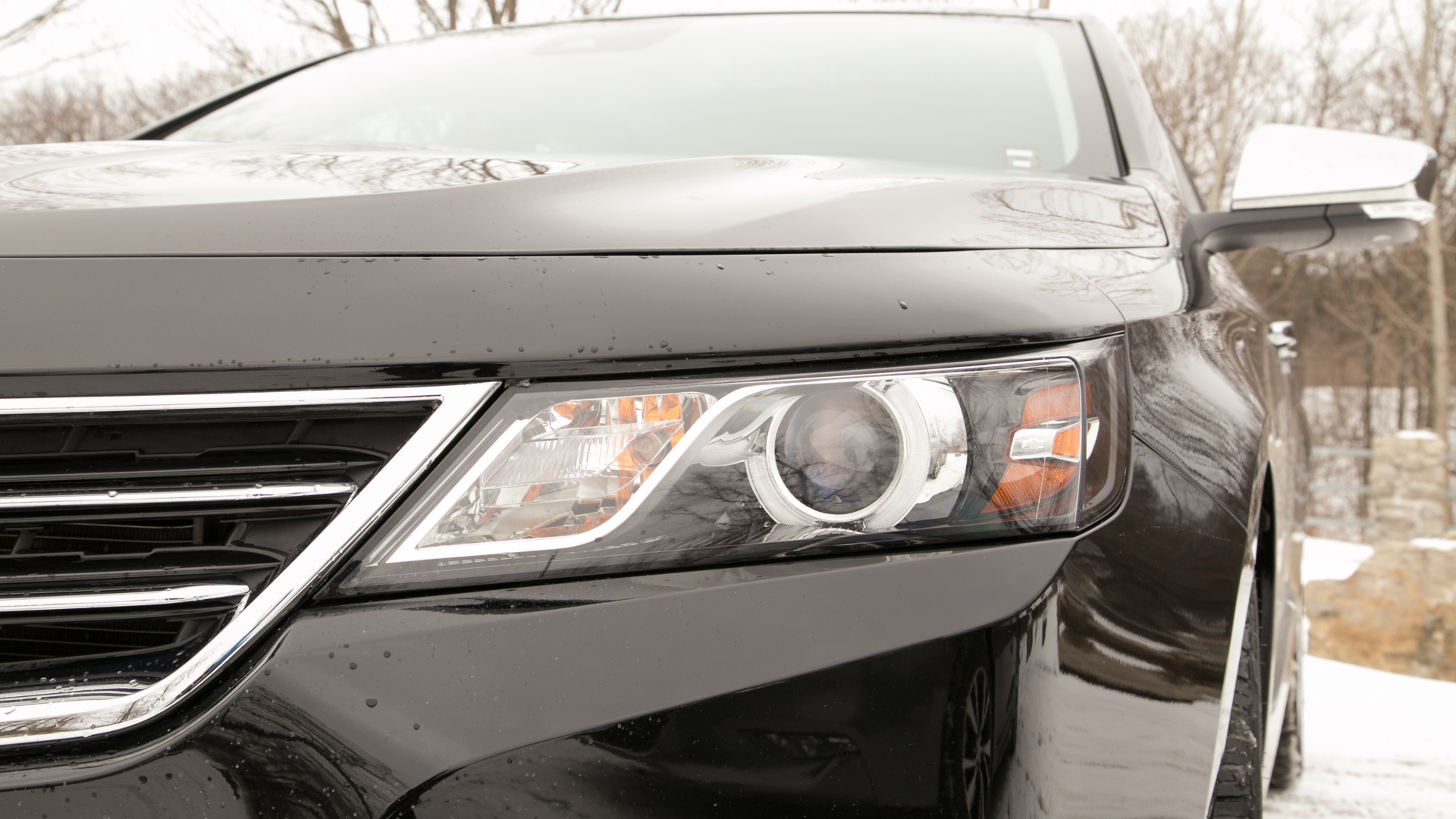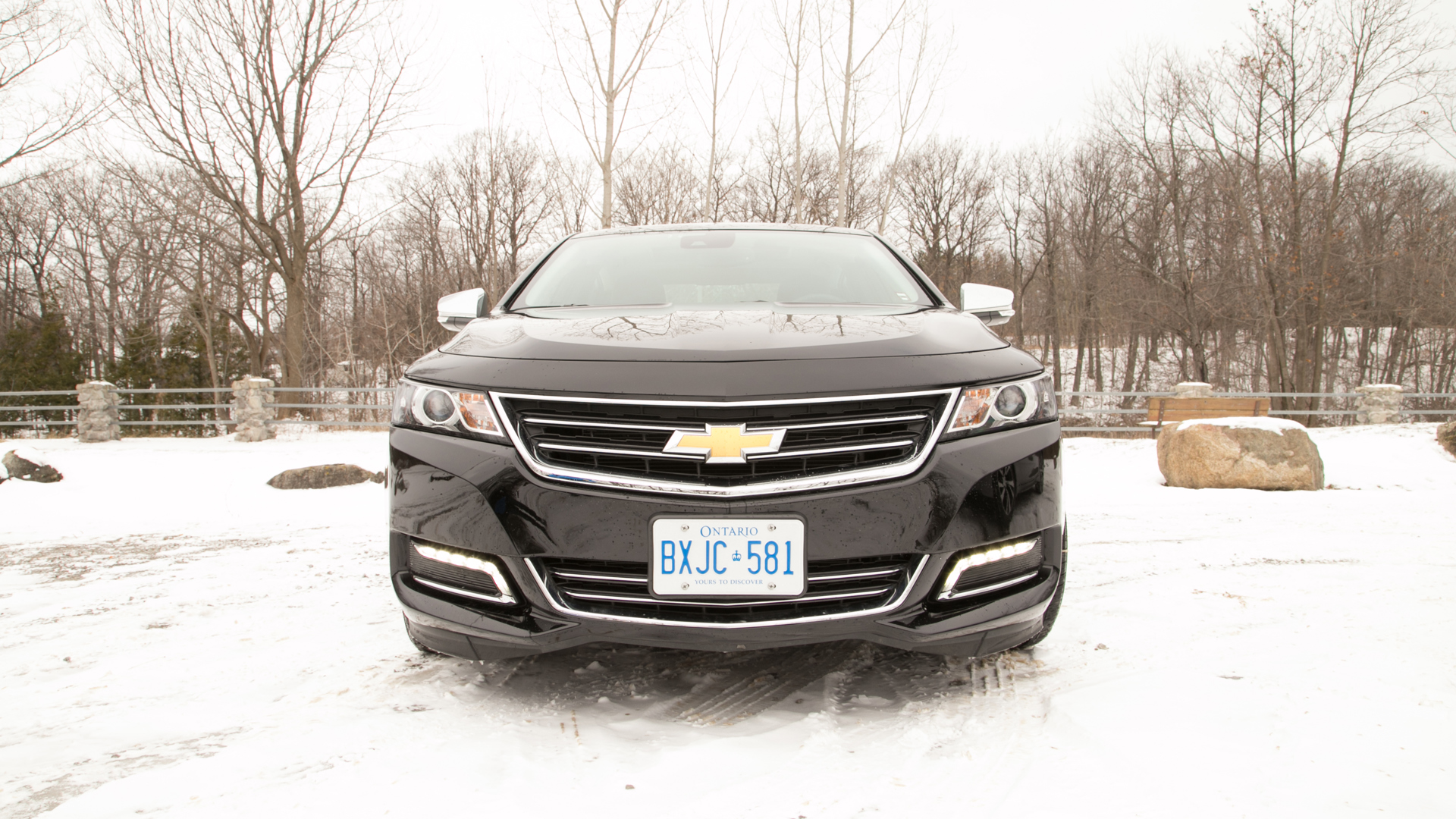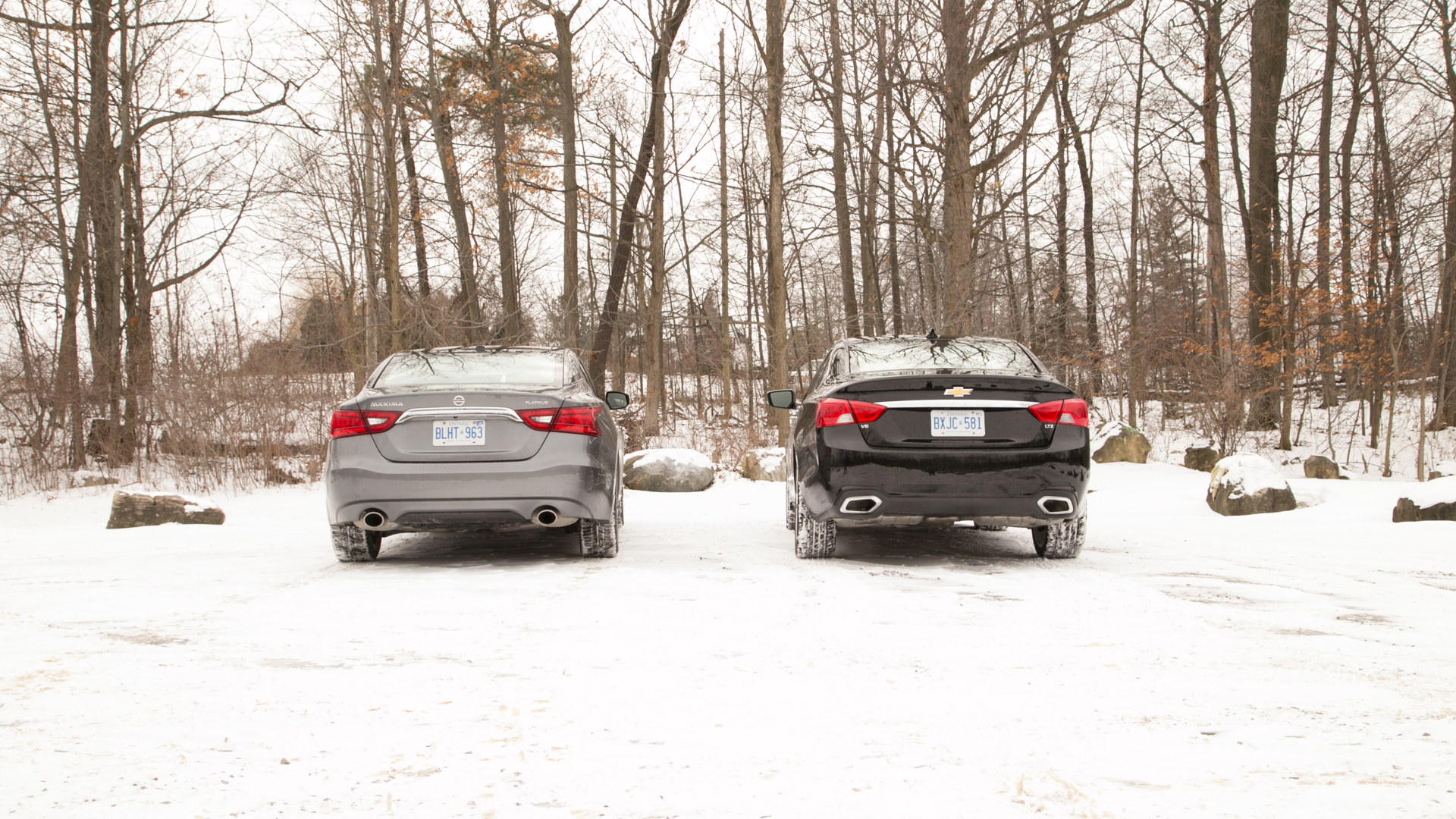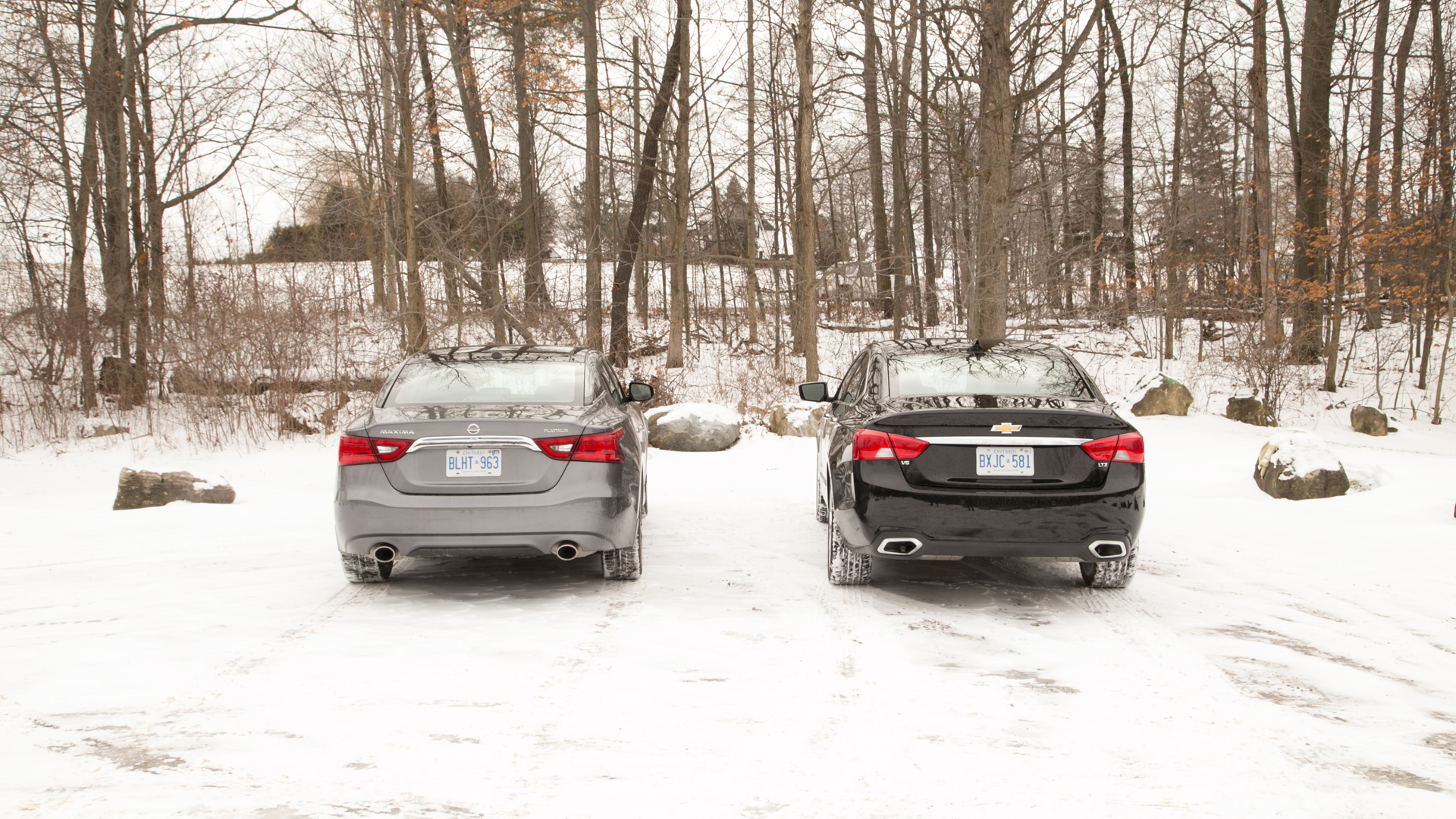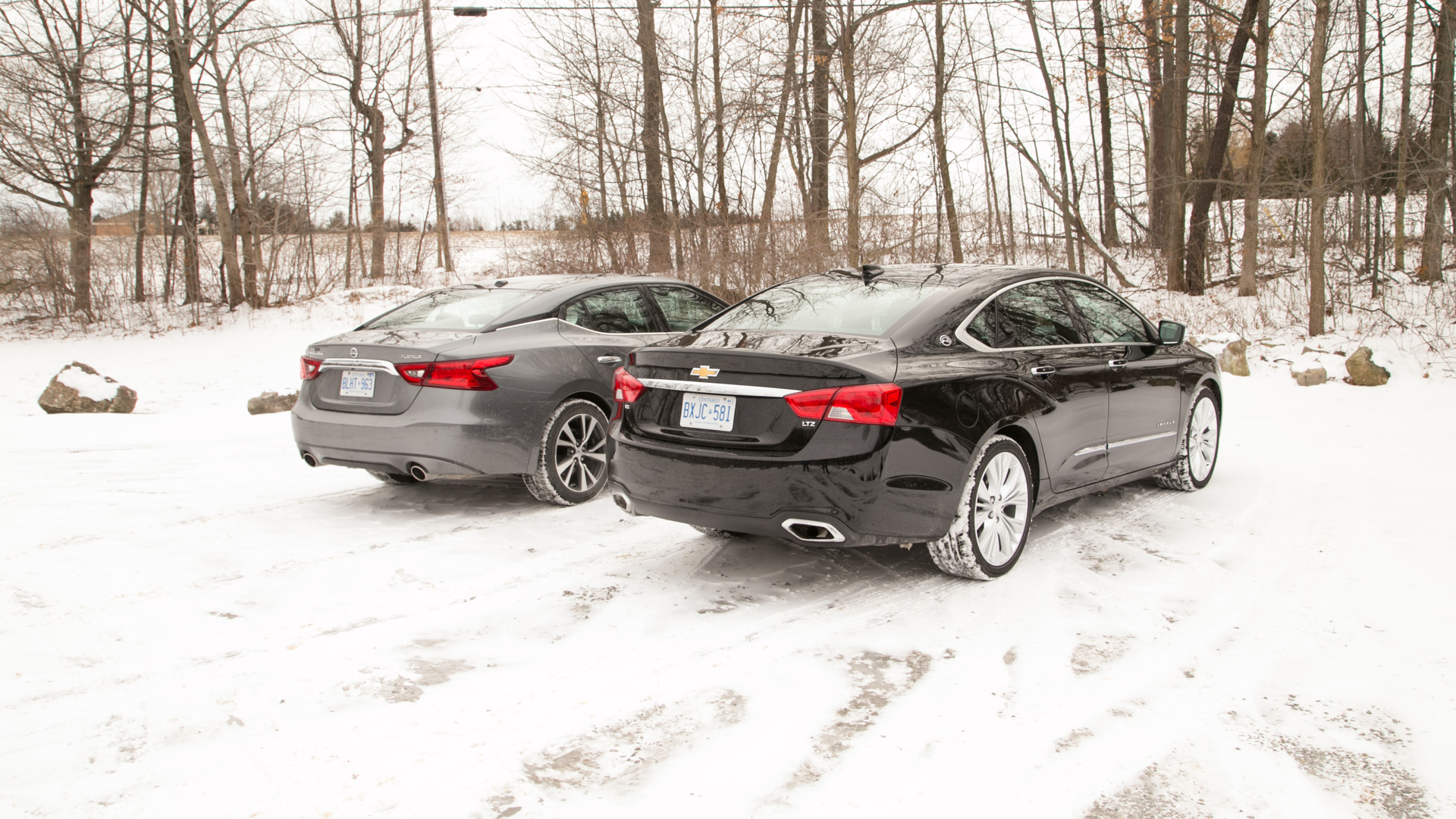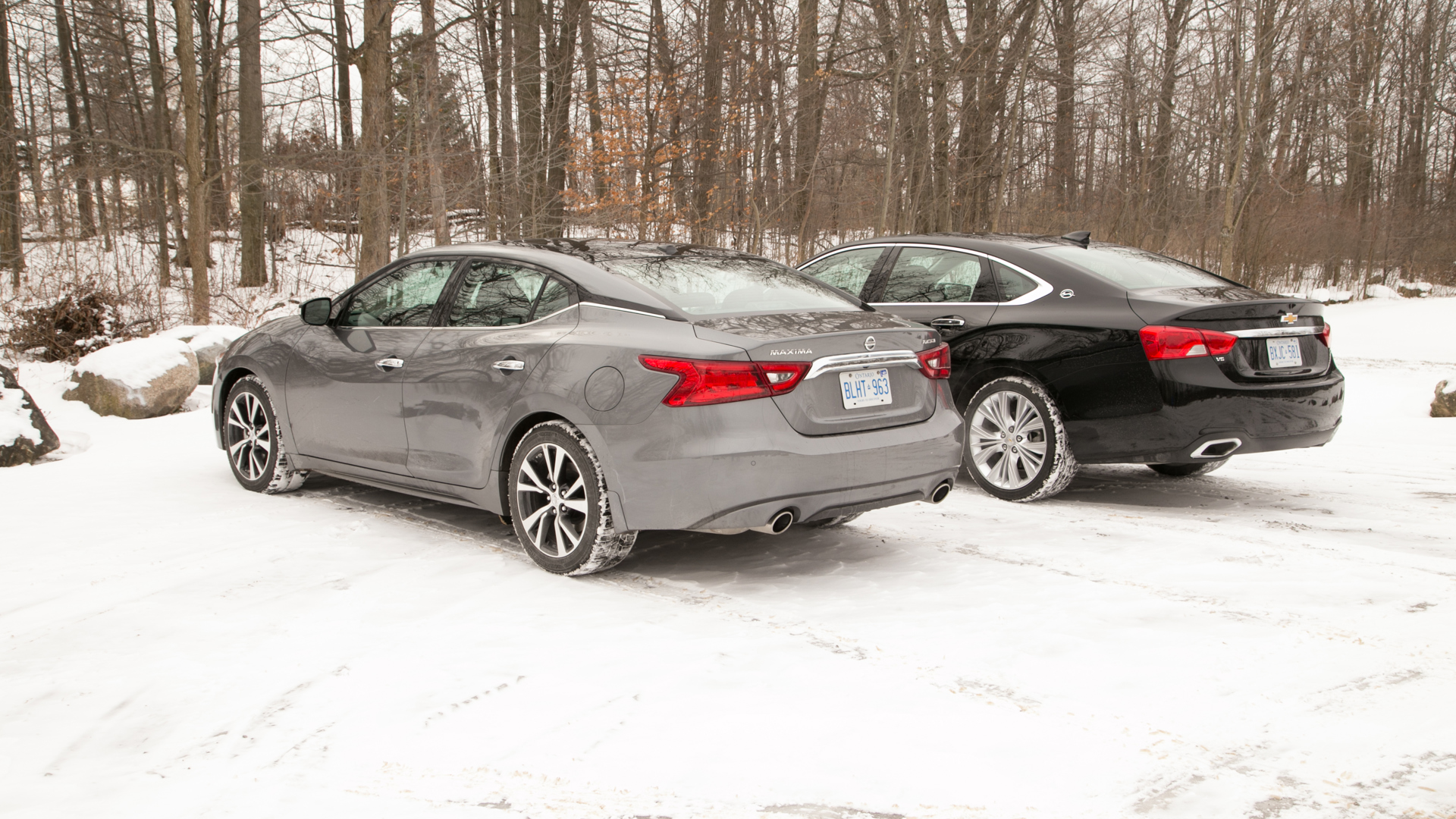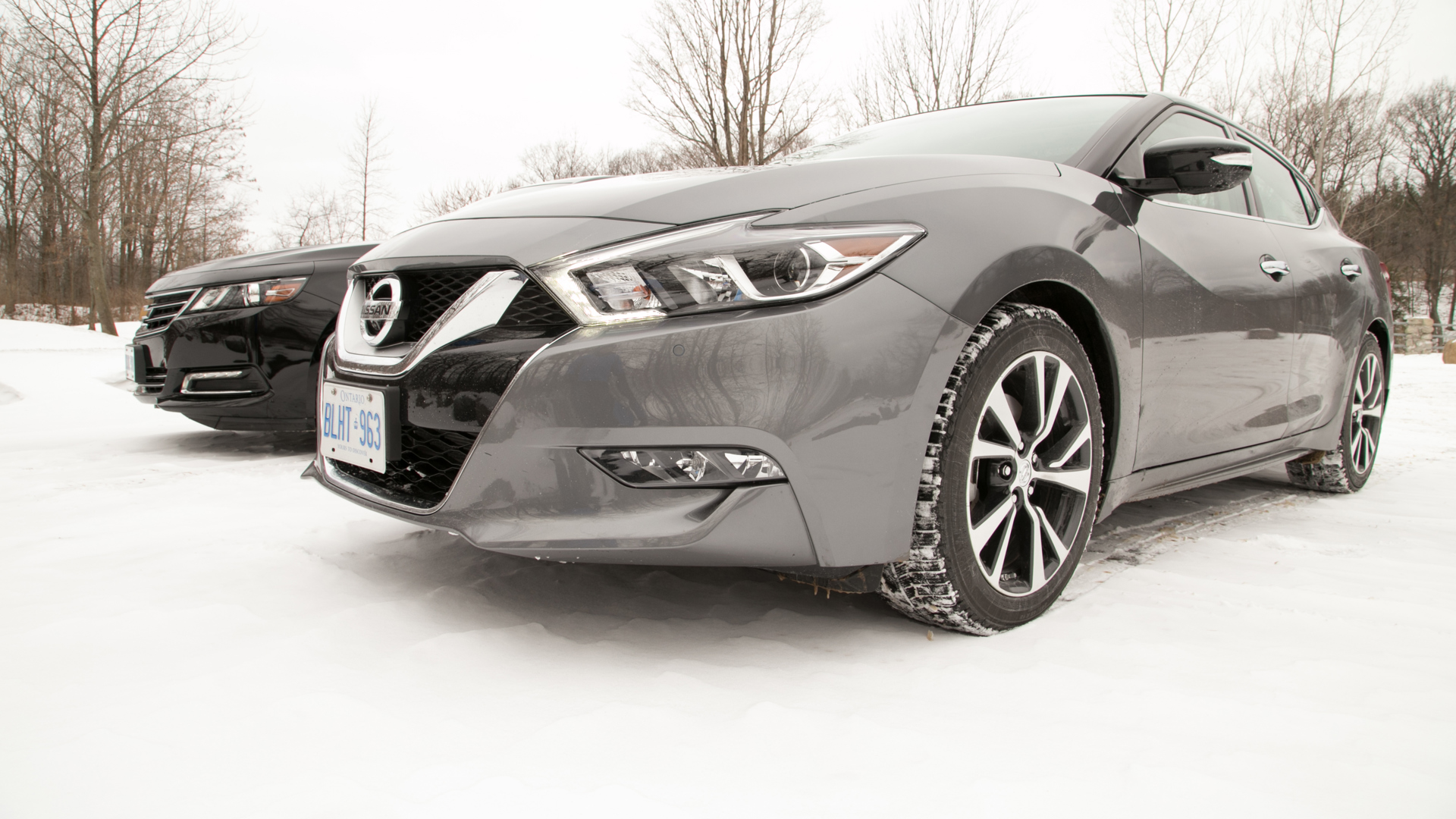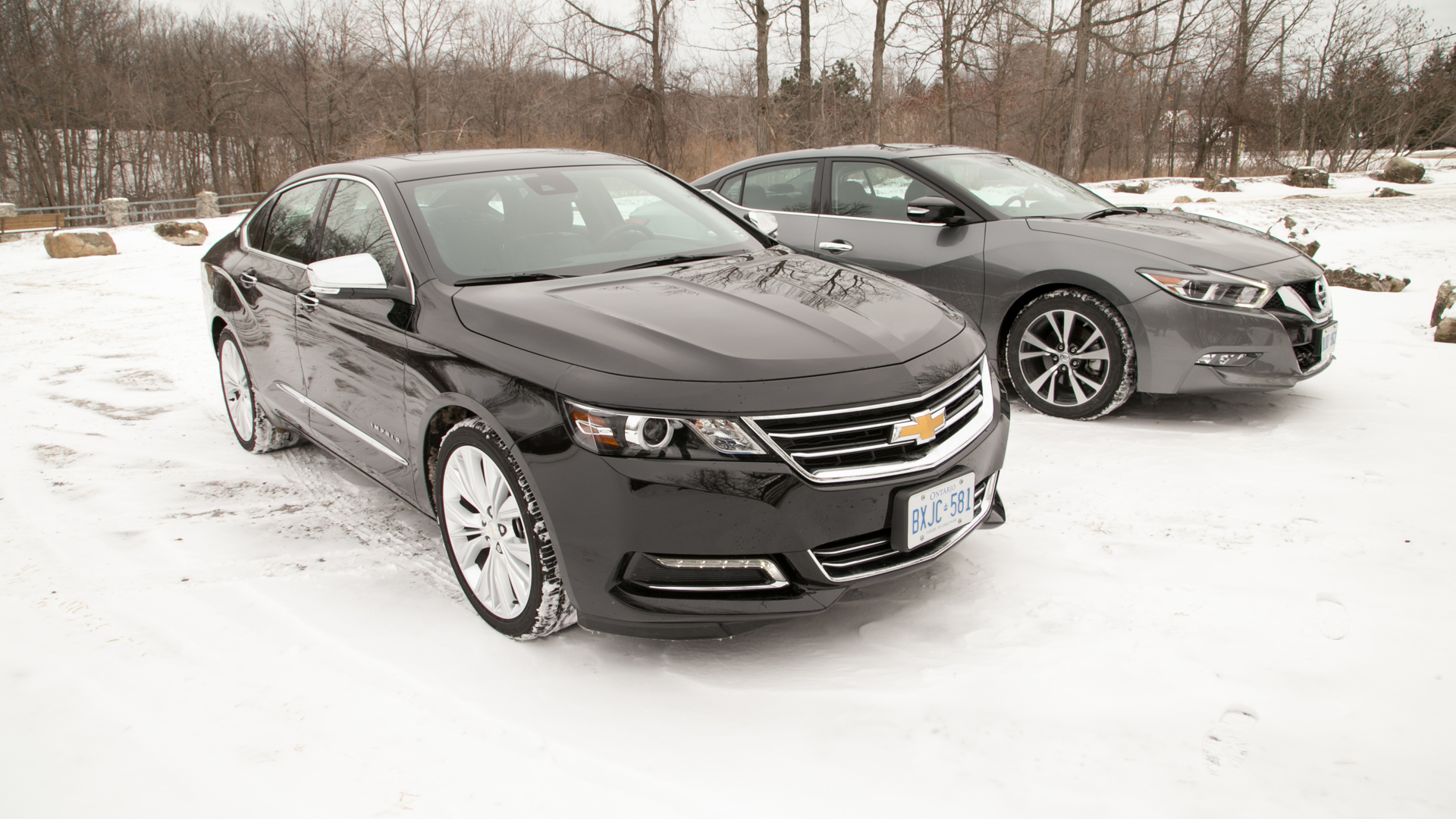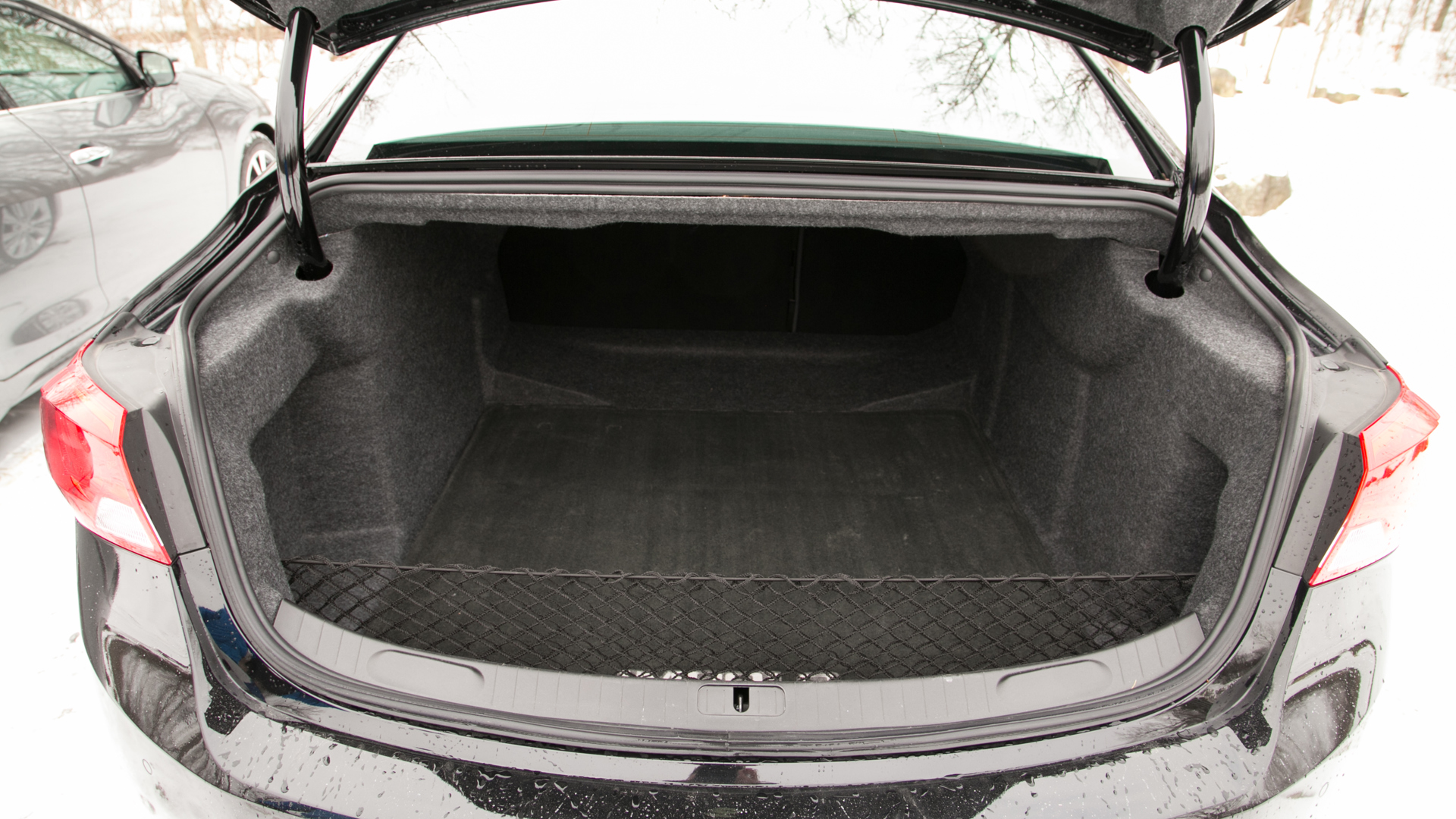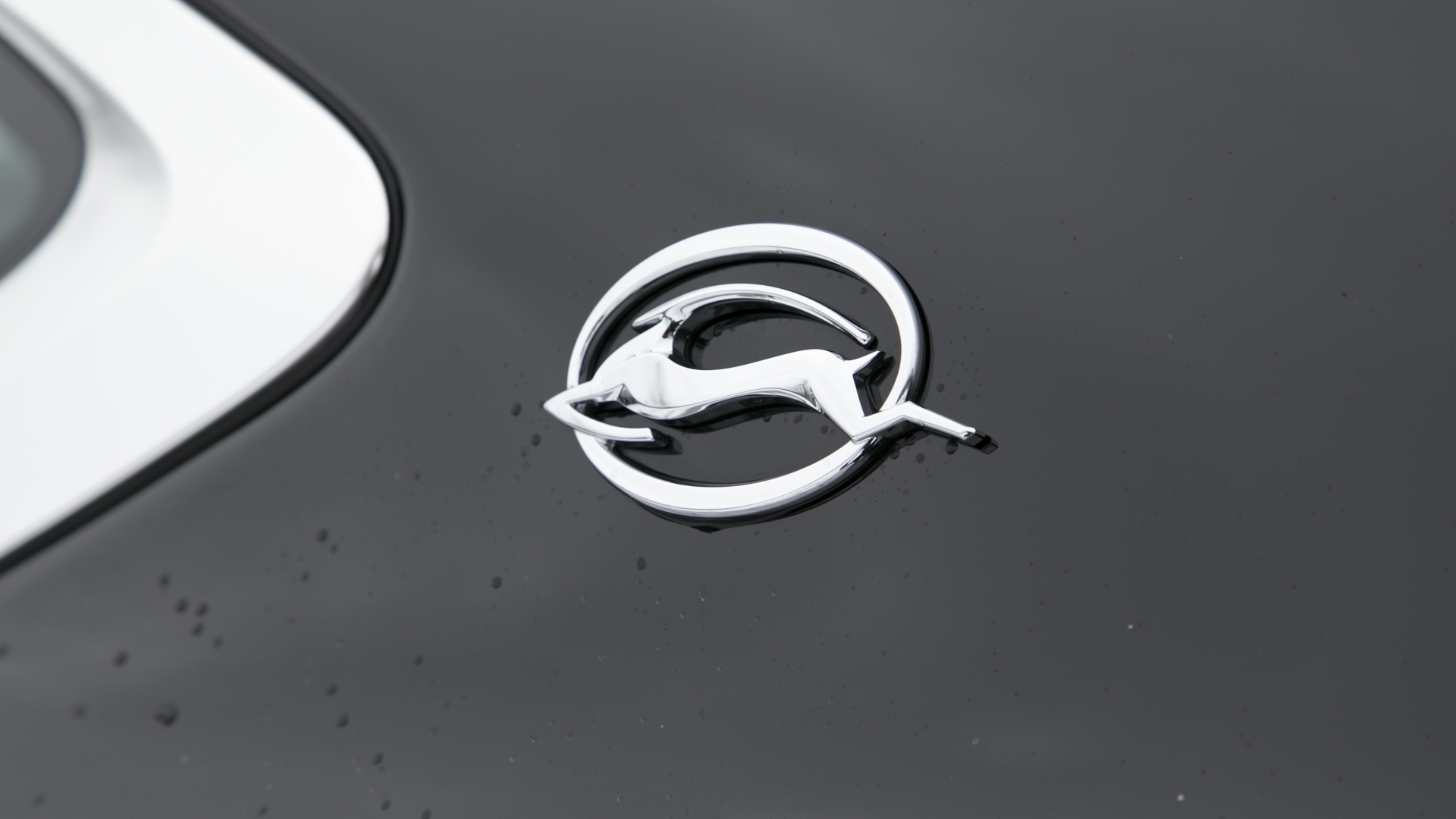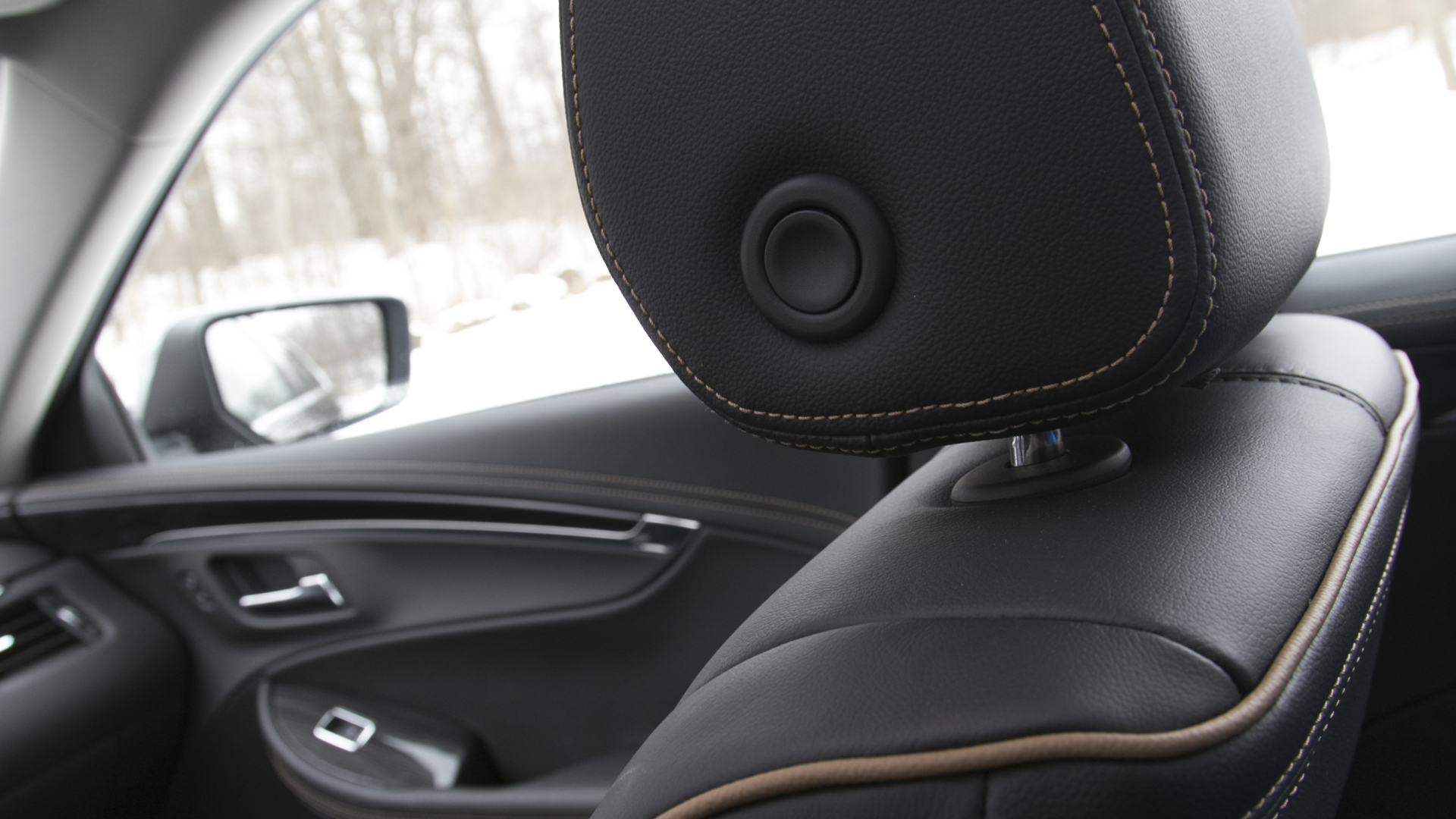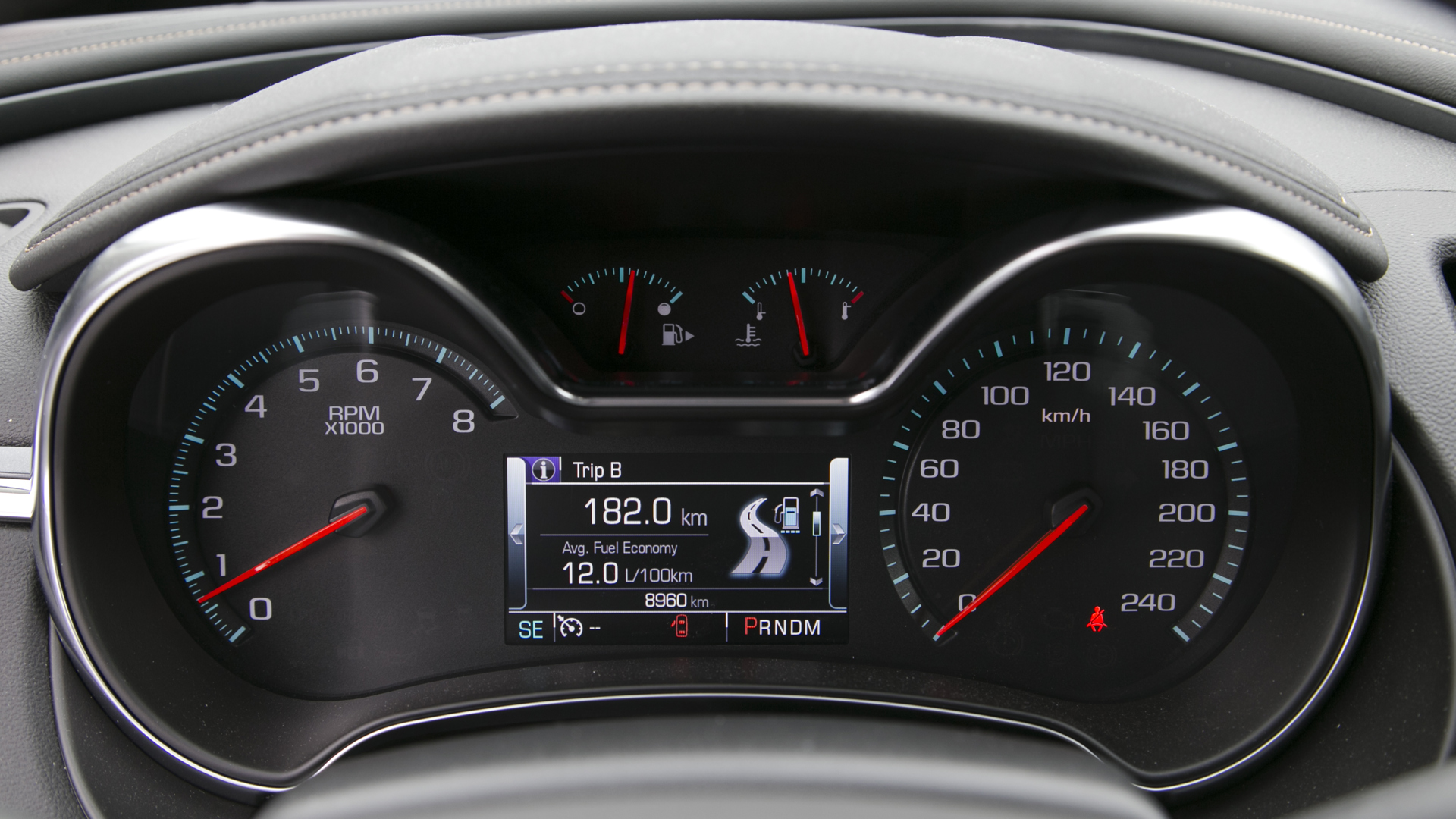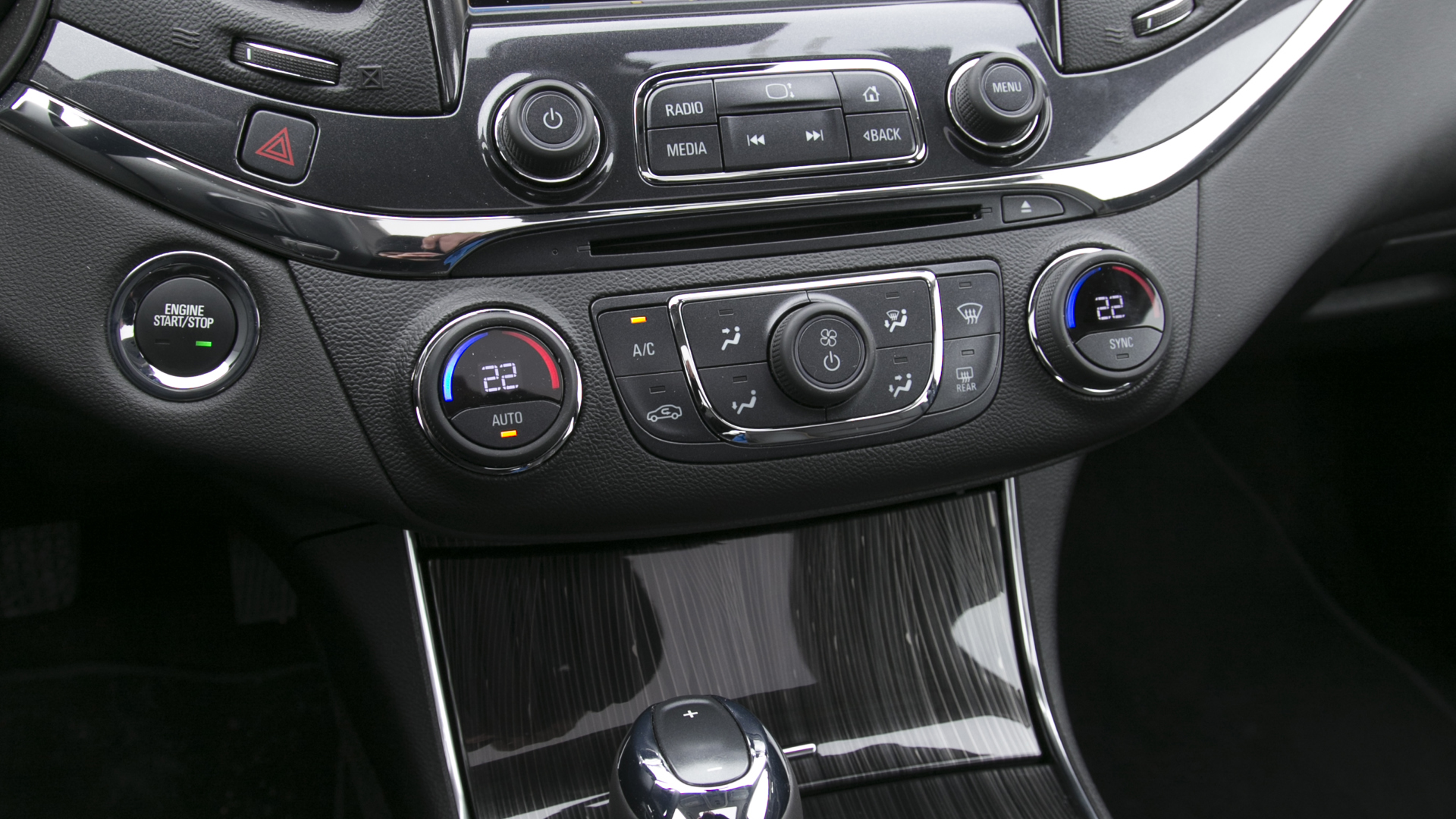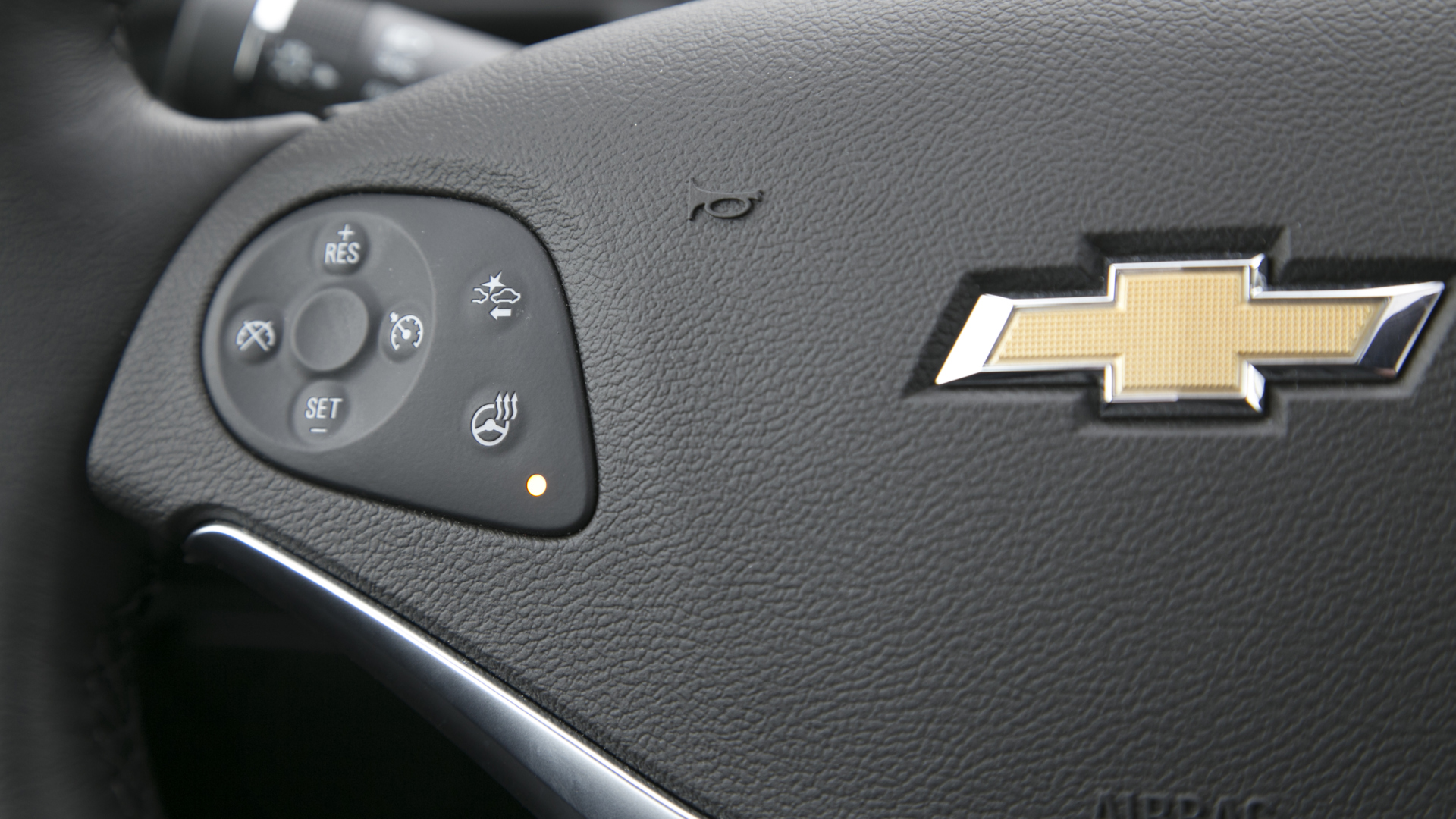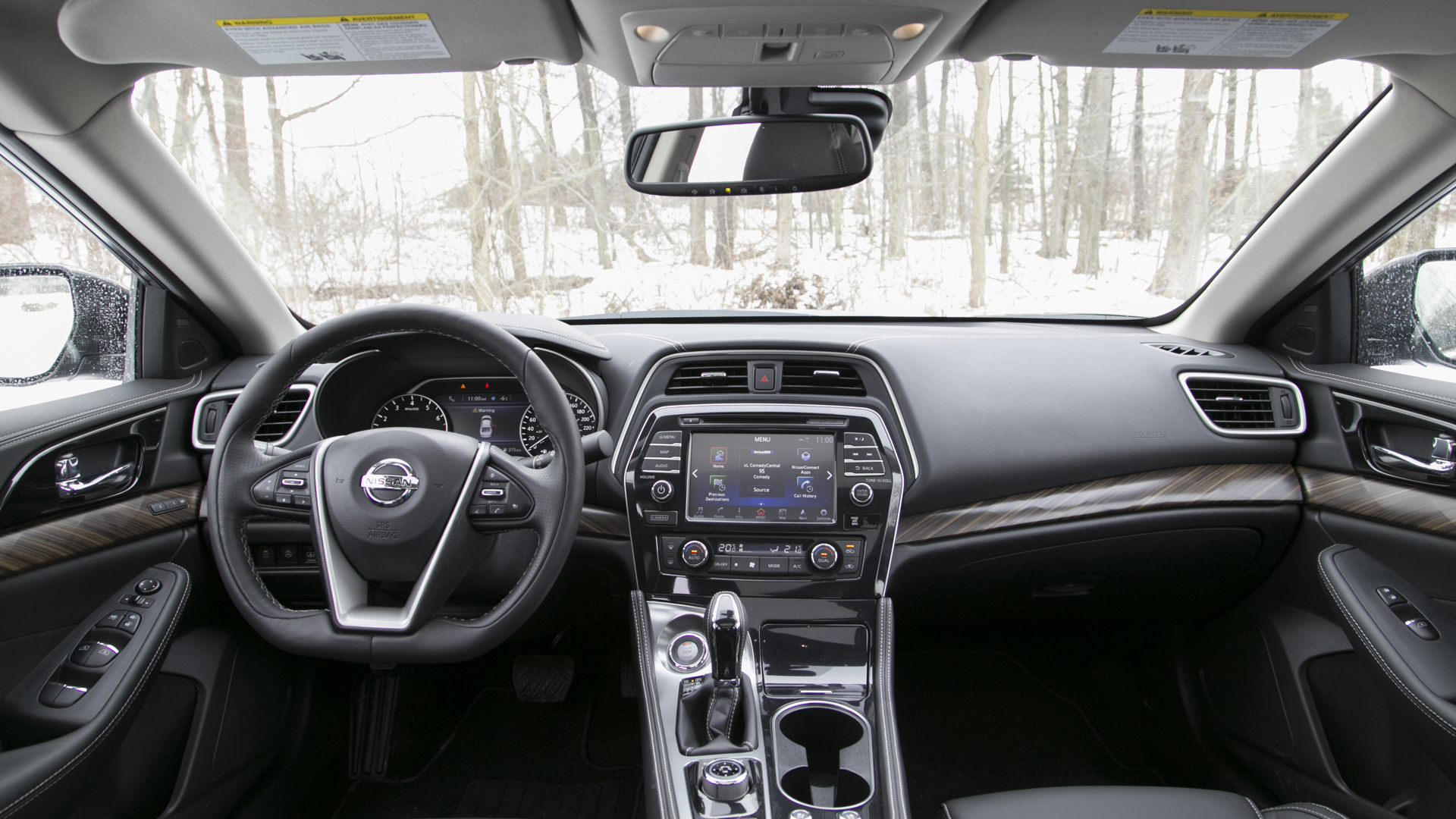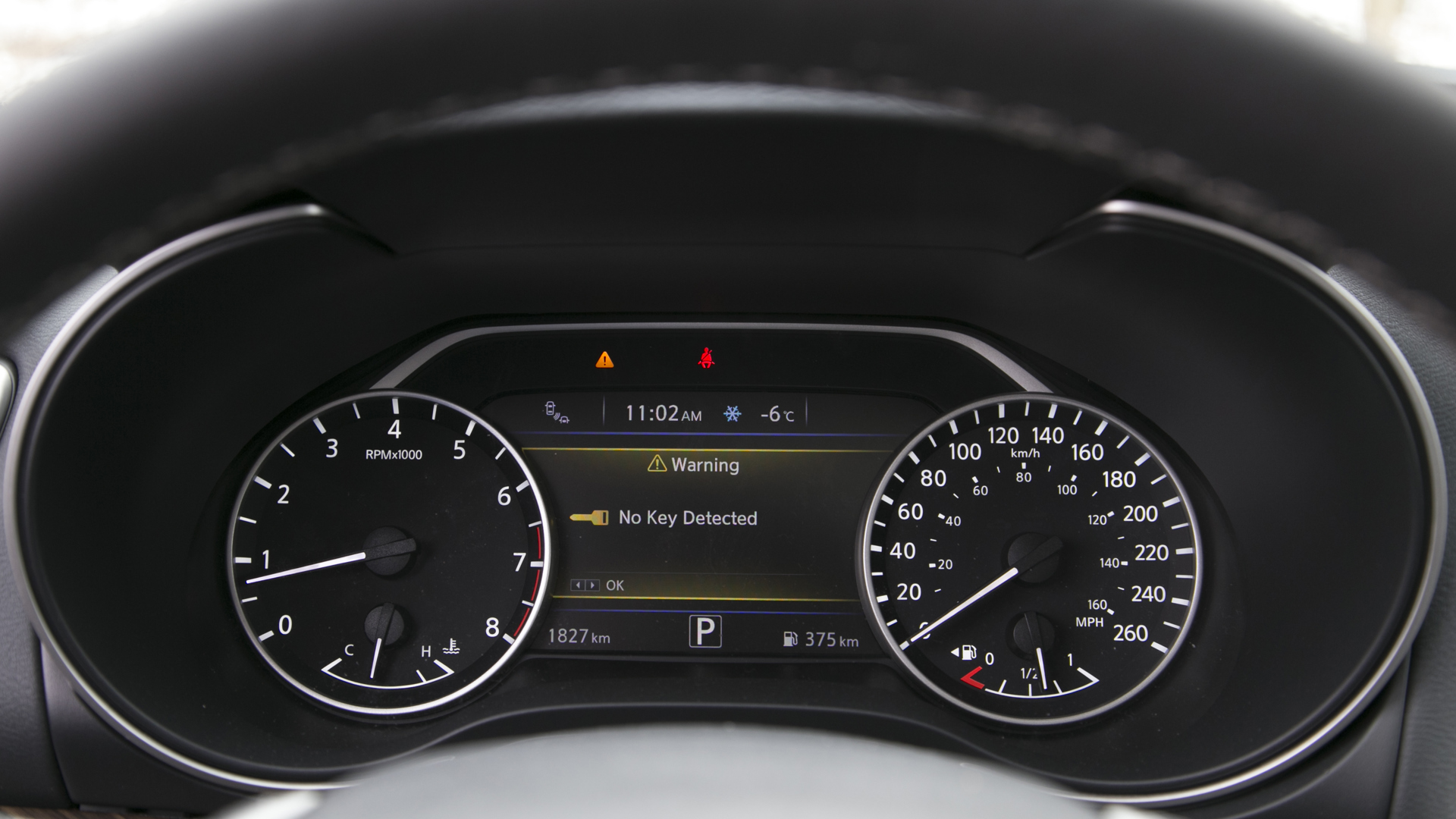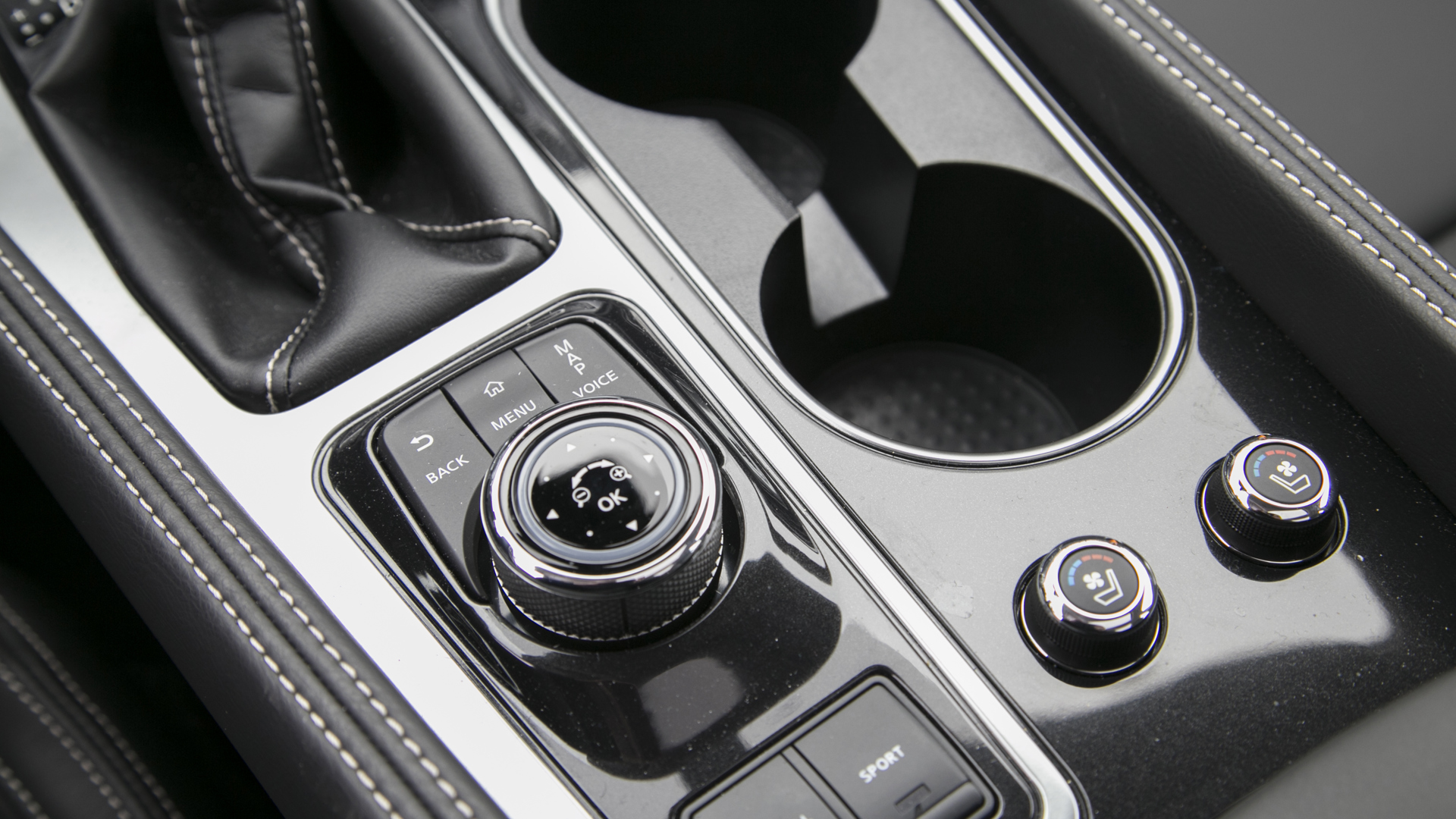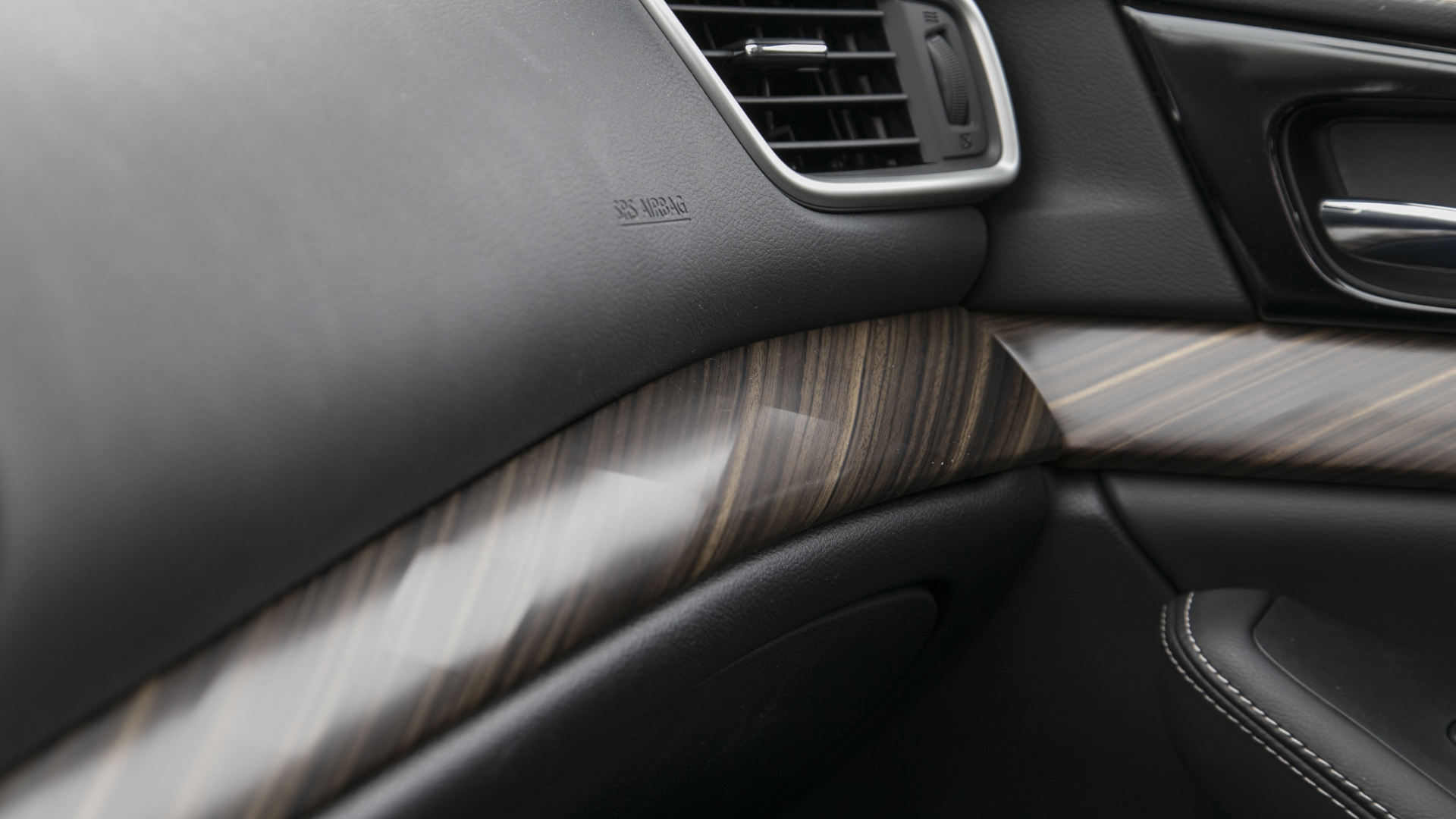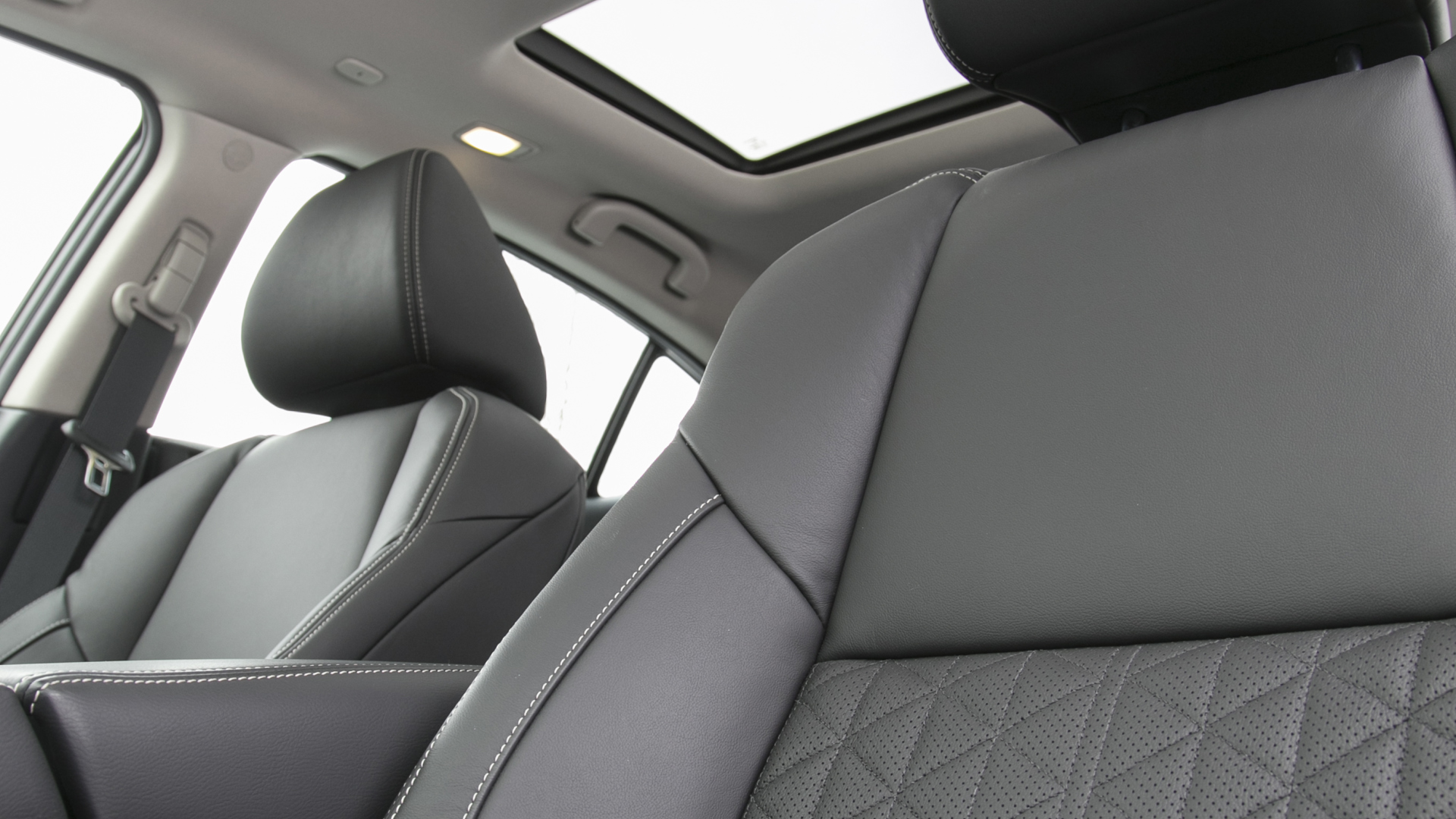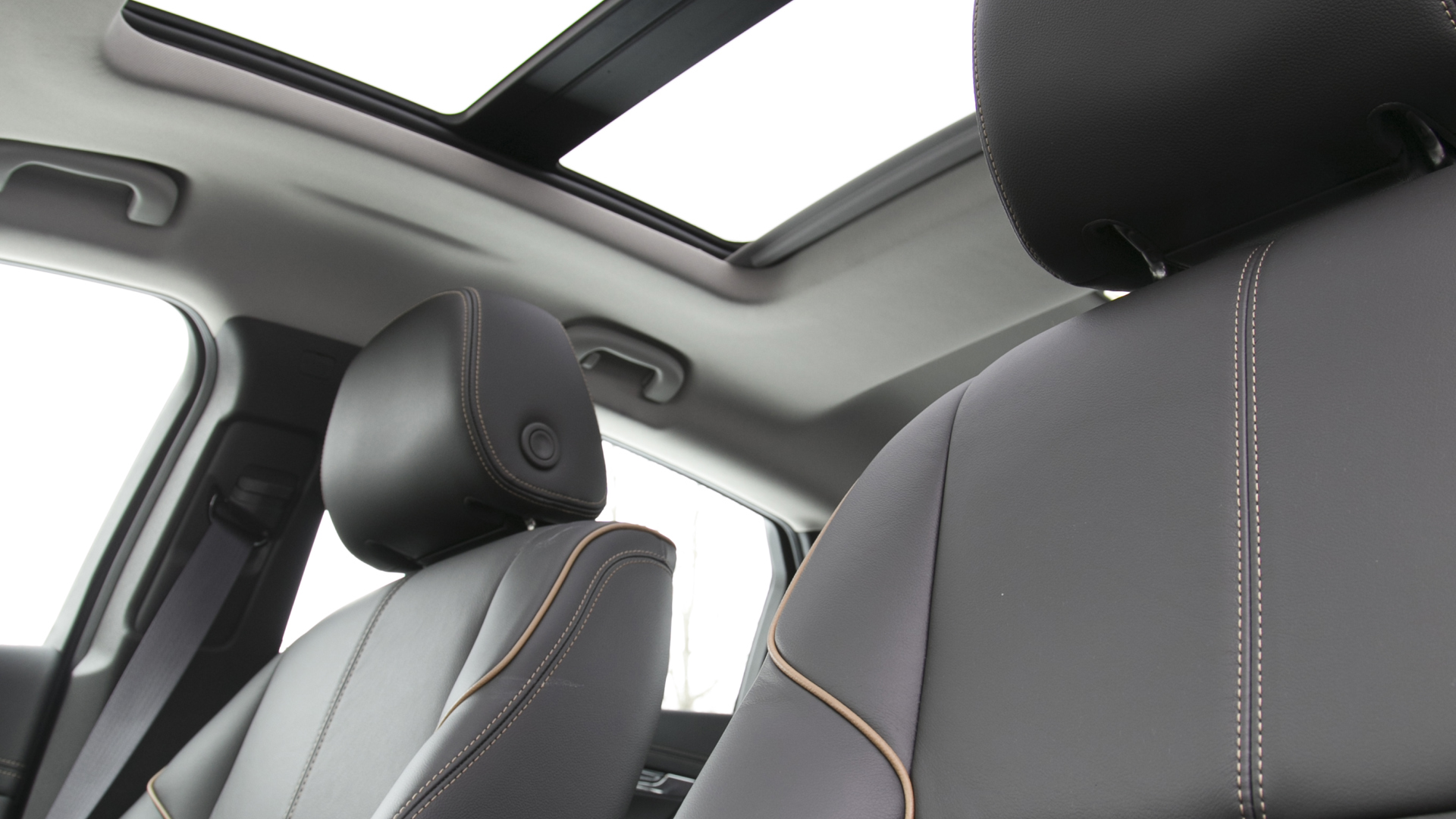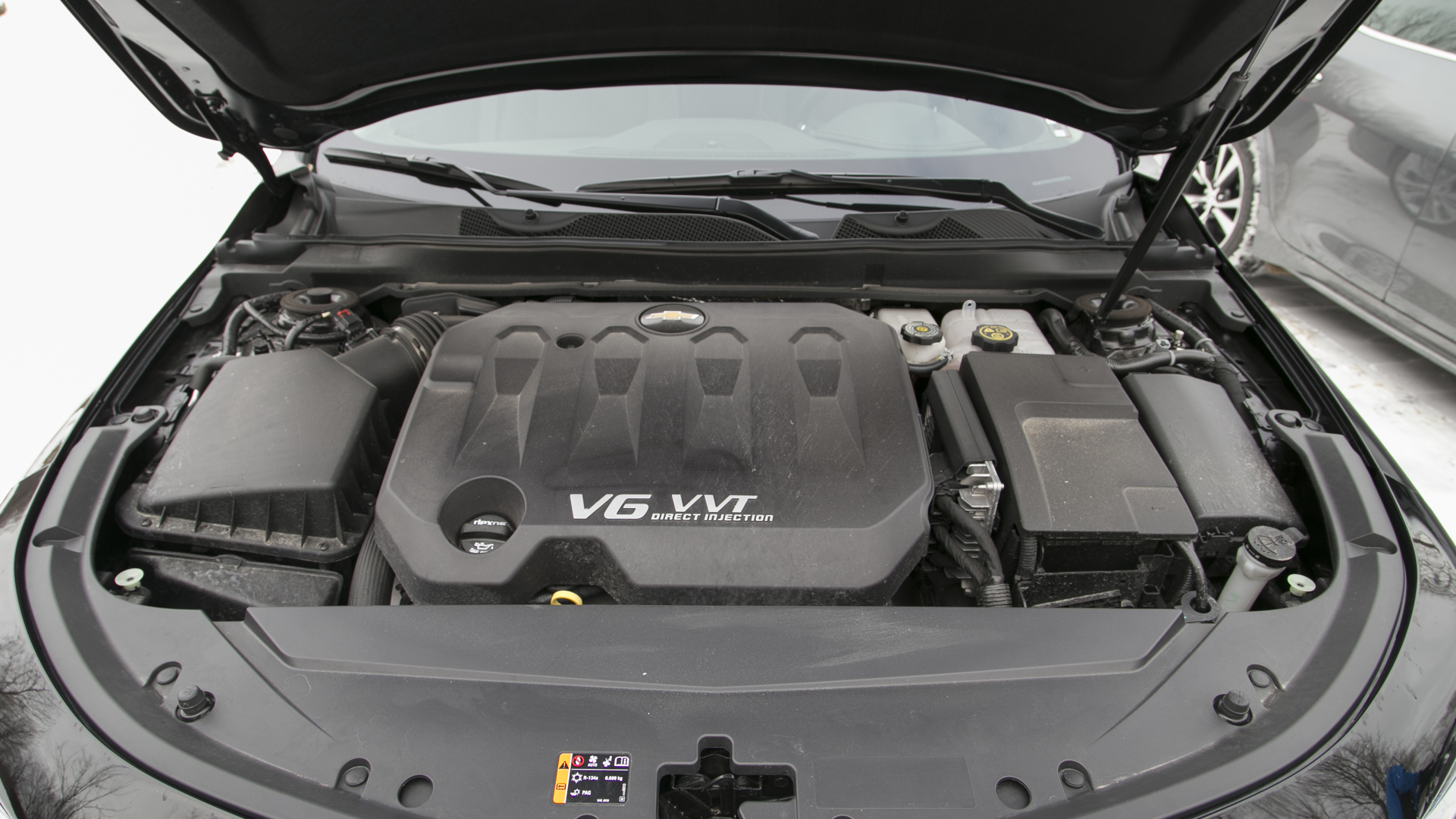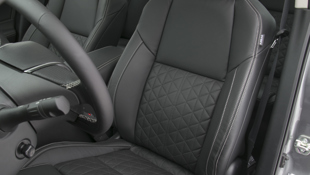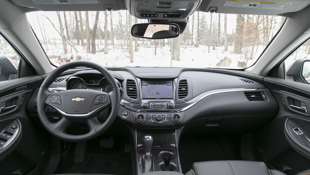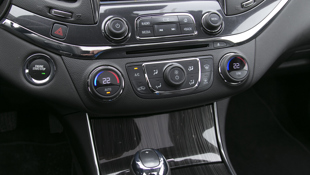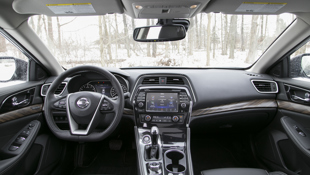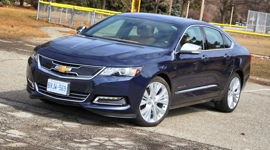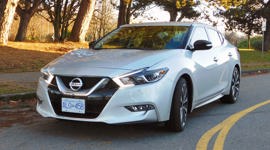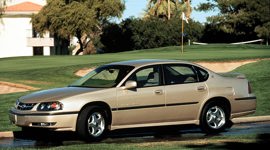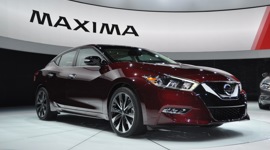Comparison Data
|
Base Price
$39,995
|
$43,300
|
|---|---|
|
Optional Equipment
Navigation system, $795; Enhanced Convenience Package, $1,365; Advanced Technology Package, $950; 20-inch Aluminum Wheels, $420.
|
Metallic Paint, $135
|
|
A/C Tax
$100
|
$100
|
|
Destination Fee
$1,650
|
$1,720
|
|
Price as Tested
$45,275
|
$45,155
|
Review and Photos by Jeff Wilson
If I’m honest, I hate it when he’s right. autoTRADER.ca’s outspoken Aussie editor, Jacob Black denied my request to pit the 2016 Nissan Maxima against one of its obvious Japanese-brand competitors, instead insisting Nissan’s flagship tangle with your grandpa’s Chevy; the fleet darling Impala.
The rear seat in the Impala approaches limo-like proportions...
I scoffed, I protested, I questioned Jacob’s sanity even more than I normally do. He presented a series of numbers on a page making his case, but ultimately, the command had been given and it was to be done.
What I didn’t see coming was that he was actually right and that either of these two cars should rightfully be considered by potential buyers of the other. There are some serious differences between them, but there is enough commonality to warrant a closer look.
Here’s what we found…
Size Matters
My biggest concern in comparing these two sedans stemmed from the belief that they’re built for completely different owners looking for completely different things, defined most obviously by their difference in size. The Impala is a big car – always has been – and indeed it is larger than the Maxima in most respects.
Every exterior dimension except for width, and every interior measurement favours the Chevrolet. The Impala casts a large shadow, but the Maxima’s interior size deficit has more to do with Nissan’s desire to aggressively style the Maxima more so than its overall footprint.
Nowhere is this more apparent than when climbing into the rear seat of the Nissan right after leaving the Chevy’s. The steeply raked roofline cuts into rear headroom enough that even an average-height adult will have his or her hairdo rearranged by the headliner.
Shoulder room and legroom are comfortable in the back of the Maxima, but in the Impala, they’re downright generous. The rear seat in the Impala approaches limo-like proportions with an abundance of passenger space in every direction, including up, despite the panoramic sunroof.
Upfront the Maxima’s dimensions are great enough to accommodate all but the most portly of passengers, though it does feel more intimate than the Impala’s expansive cabin. The Chevy’s seats (heated and cooled) are comfortable and prove to be a decent place to spend time behind the wheel, but Nissan’s Zero Gravity front seats are second-to-none.
First experienced in the Rogue and Altima, I can confirm that even after many consecutive hours behind the wheel, the magic employed by these thrones will keep backs, and backsides, fatigue-free. What’s more, on our Platinum trim Maxima, the leather is finished in a quilted diamond-pattern that looks truly luxurious.
Rear visibility in the Impala is seriously compromised due to the very high rear parcel shelf behind the backseat. The upside to this impediment (solved by the back-up camera Chevy provides) is a trunk that’s simply mammoth in capacity. At over 532 L, the Impala’s cargo capacity is nearly 130 L greater than the already decently-sized Maxima’s hold. If you’ve got a lot of junk for your trunk, the big Chevy is the car for you.
| Length (mm) | Width (mm) | Height | Wheelbase | Cargo Volume (L) | Passenger Volume (L) | |
| Chevrolet Impala | 5,113 | 1,854 | 1,496 | 2,837 | 532 | 2,973 |
| Nissan Maxima | 4,897 | 1,860 | 1,436 | 2,775 | 405 | 2,744 |
Style Also Matters
Sales of mid-size and large sedans are dwindling thanks to the remarkable popularity of crossovers and SUVs. So any manufacturer daring to bring out something new in the sedan realm darn-well better make a statement, and that’s exactly what Nissan has done with its Maxima. Nissan has succeeded in designing a car that’s truly unique, highlighted by aggressive, sweeping accent lines down the flanks and blacked-out A-pillars. The latter creates a floating roof effect that slides fluidly to the upswept shoulder line over the rear fender.
The Maxima’s nose is a mix of chunky chrome bars, jagged-angle headlights and strange openings and shapes.
The overall effect is that the Maxima won’t be mistaken for lesser-designed, more anonymous sedans, but honestly looks wildly over-styled to this eye from every angle except the squat derrière. Five years from now when Nissan’s corporate design language has evolved to the next collection of stylistic fads, this Maxima is going to become woefully outdated and overwrought.
Conversely, the conservatively styled Impala suffers more from familiarity (and anonymity?) than any specific fashion faux pas. The proportions of the Impala – while grand in scale, are all harmonious and cleanly executed. The big Chevrolet is a handsome car, and admittedly, finished in black as our press car was, I enjoyed imagining I was Special Agent Wilson in my FBI-issued sedan.
Inside, generic, Government Issue describes the Impala’s interior design pretty well, too. Unfortunately it’s not a compliment here, where the aesthetic – particularly of the gauges – feels dated and a class below the Maxima’s. In fairness, Chevrolet has done a very good job of logically laying out the controls, which are both easy to find while driving, and easy to use. A boon, to be sure, for older drivers who will appreciate Chevy’s resistance to change things like the use of rotary knobs that just work well for primary audio and climate controls.
Chevy MyLink with its large touchscreen set up is pretty much as simple and straight forward as these systems come these days, and the Bose stereo has a decent sound to it. GM also ties in a 4G LTE WIFI hotspot in the Impala, which is a nice feature for tech-savvy occupants.
The Maxima’s primary controls also employ the common sense of rotary knobs, but its infotainment system takes usability one-step beyond the Impala’s by employing both touchscreen and Display Commander functionality. The latter is a rotary knob that can be used without taking eyes off the road, to seek information and activate commands. A secondary screen between the primary gauges allows for greater information set up flexibility than the Chevy’s older system. Plus, Nissan gives a 360-degree view for parking through its screen; the Chevy’s is rear-view only.
And while the overall quality of materials used throughout the Nissan’s cabin feel richer than the Chevrolet’s, both cars feature some wildly obvious fake wood in sizable quantities. Not only does the Maxima’s “plood” feature a garish graining to it, it’s also been molded to have a slight diamond pattern that catches the light from certain angles. We could do without fake wood in either car, no matter how creatively it’s executed.
But What Are They Like to Drive?
Nissan fits the Maxima with a compact, thick-rimmed, square-bottom steering wheel, the sort you’d find in a proper full-on sports machine. And at one time, long ago, Nissan convinced most of us that the Maxima was the 4-Door Sports Car (4DSC) – the car grownups moved into when their 300ZX could no longer contain the responsibilities of adulthood.
Then the Maxima grew bigger and older and softer and the 4DSC brand dwindled away. Nissan has tried with swoopy styling and that sporty steering wheel to pretend their flagship is still the 4DSC it once was, but we’re here to tell you that ship has long since sailed far away.
The 3.5L V6 puts out a healthy 300 horsepower (only five short of the Impala) and 261 lb-ft. of torque (again, just three fewer than the Chevy) that gets the Nissan up and running briskly enough, but it’s filtered to the wheels through a CVT transmission that is anything but sporty.
Steering and braking feel, and the overall handling of the Maxima are sporti-er than the Impala’s (whose steering is wildly over-boosted giving it virtually no feel whatsoever), but the Nissan should never be mistaken for a sport sedan, at least not in this luxurious Platinum trim.
Nobody expects the Impala to drive like a sport sedan, and it surely doesn’t. The 3.6L V6 motivates the car effortlessly enough, but nothing about the way the Chevy moves suggests any sporting pretenses. The Impala always reminds its driver that it’s a big car, constantly battling the forces of physics in everything it does.
But there is one on-road aspect that earns the Impala some big kudos: its ride. The softer-sprung Chevrolet, with its gargantuan wheelbase is a sublime highway cruiser, swallowing bumps with ease and providing an all-round luxurious ride seldom found even on true luxury cars these days. For buyers looking for a comfortable sedan to use for long distance travel, the Impala is the run away victor.
What About Value?
Multi-zone climate controls, panoramic moonrooves, heated and cooled seats and heated steering wheels are found on both our test cars, as are a significant suite of passive and active safety features (adaptive cruise control on the Maxima, lane departure warning on the Impala). Both give drivers a good sounding stereo and a comprehensive set of functions through the infotainment system, too. And while the starting price of our Maxima Platinum is a few grand dearer than the base Impala LTZ, when comparably equipped as our two cars were, they’re within barely more than $100 of each other.
The Maxima’s on-paper fuel efficiency is notably better than the Impala’s with a combined government rating at 9.5 L/100 km for the Nissan versus 10.6 L/100 km for the Chevrolet. During our comparison test with mixed rural, urban and freeway driving, our Maxima delivered an average of 8.8 L/100 km, whereas the Impala showed an alarming 12.1 L/100km consumption rate.
Still, with the Maxima being a new-for-2016 design versus the aging Impala, there are bigger discounts and incentives available for the Chevrolet at the time of writing which should offset the extra fuel costs and then some compared to the Nissan.
Which One Should You Buy?
Jacob proclaims the Maxima to be his favourite based on its significantly better interior finishes and superior handling manners, as well as its runaway victory in fuel efficiency. The problem is, despite superior handling, the Maxima is no sport sedan and those looking for a sedan who place performance at the top of their wish list would do well to look at neither of these sedans.
And while dollar value is a wash for these two, it comes down to luxury for me. The Maxima is finished in nicer materials and its front seats are unmatched for comfort, but the Impala’s interior is still a nice place to be. If you’ve got people – or stuff – to carry, the Chevrolet starts to look pretty good with all that extra space. Factor in its superior on-road ride and the Nissan no longer has a sure win.
Chevrolet’s restraint in the exterior design compared to the Maxima’s over-the-top exterior styling is the subjective quality that just barely ekes out the Impala as my pick between these two surprisingly close competitors.


